
- Premium Help
- Solved Assignment
- Guess Paper
- Solved Question Paper
- IGNOU Assignment
- Hall Ticket
- Revaluation Result

BEGAE 182 Solved Assignment 2023-24: Free PDF Download
Course tittle, course code, assignment question.
BEGAE 182 Solved Assignment 2023-24 ( English Communication Skills ) FREE PDF Available here. All the assignment questions answers are solved in this article. Some students who need the BEGAE 182 Solved Assignment PDF, can download the pdf from this blog.
Before may any assignment match the assignment questions with the assignment question paper.
YOU MAY ALSO LIKE: Download more solved assignment pdf free
BEGAE 182 Solved Assignment 2023-24
Note: Attempt all the questions.
1) What do you understand by the term ‘non-verbal communication’? What are its advantages?
Ans: Non-verbal communication refers to the transmission of information and meaning through non-linguistic cues and signals, such as body language, facial expressions, gestures, posture, tone of voice, and various other non-spoken forms of communication. These cues can convey emotions, attitudes, and intentions without using words. Non-verbal communication is a fundamental aspect of human interaction and can greatly influence the way we interpret and understand messages.
Advantages of non-verbal communication include:
1. Complementing Verbal Communication: Non-verbal cues often complement and enhance verbal messages. They can reinforce or contradict what is being said verbally, providing additional context and clarity.
2. Expressing Emotions: Non-verbal communication is particularly effective in expressing emotions. Facial expressions, tone of voice, and body language can convey feelings and moods more powerfully than words alone.
3. Enhancing Understanding : Non-verbal cues can help clarify messages and reduce the risk of miscommunication. They provide extra information that can aid in understanding the speaker’s intent.
4. Conveying Cultural and Social Norms: Different cultures and social groups have their own non-verbal communication norms and customs. Understanding and using these cues appropriately can help build rapport and avoid misunderstandings.
5. Establishing Credibility: Non-verbal signals, such as maintaining eye contact and using confident body language, can enhance a speaker’s credibility and persuasiveness.
6. Non-Verbal Feedback: Non-verbal cues from the listener, such as nodding, smiling, or frowning, provide instant feedback to the speaker, indicating whether the message is being understood or well-received.
7. Non-Verbal Signals in Conflict Resolution : In conflict situations, non-verbal cues can be essential for resolving disputes. Active listening, empathetic gestures, and open body language can help defuse tense situations.
8. Non-Verbal Communication in Relationships: Non-verbal signals play a crucial role in building and maintaining personal relationships. They convey affection, interest, and trust.
9. Communication in High-Stakes Situations: In situations where words may not be appropriate or safe, such as emergency response or security operations, non-verbal signals can be vital for conveying information and coordinating actions.
10. Cross-Cultural Communication: Non-verbal cues can bridge language barriers and facilitate communication in multicultural settings.
2) Write a short note on Macro functions of communication.
Ans: Macro functions of communication refer to the broad and overarching purposes or objectives that communication serves within a society, organization, or community. These functions are essential for the functioning of social groups and the exchange of information on a larger scale. There are several macro functions of communication, including:
1. Informative Function: Communication at a macro level serves to inform individuals, groups, and the general public about events, news, developments, and essential information. This function ensures that people are aware of current affairs and relevant knowledge, helping them make informed decisions.
2. Persuasive Function: Communication is often used to persuade and influence others’ beliefs, attitudes, and behaviors. It is employed in advertising, marketing, politics, and advocacy to convince people to adopt certain viewpoints, buy products, or support specific causes.
3. Socialization Function: Communication plays a crucial role in socialization by transmitting cultural norms, values, and traditions from one generation to the next. It helps individuals learn the accepted behaviors and expectations of their society or community.
4. Regulatory Function: Communication is used to establish rules, regulations, and laws within a society or organization. It helps maintain order and compliance by setting expectations and consequences for non-compliance.
5. Integrative Function: Communication serves to bring people together, fostering a sense of unity and belonging. It promotes cooperation, collaboration, and shared identity among group members.
6. Entertainment Function: Communication provides entertainment and leisure through various forms, such as films, music, literature, and sports. Entertainment helps people relax, unwind, and enjoy their leisure time.
7. Decision-Making Function: Communication is crucial for making collective decisions within organizations, governments, and communities. It involves the exchange of ideas, opinions, and information to reach consensus and determine courses of action.
8. Record-Keeping Function: Communication is used to document and archive information, preserving knowledge for future reference. This is particularly important in areas like history, science, and law.
9. Conflict Resolution Function : Communication helps resolve disputes and conflicts by facilitating dialogues, negotiations, and mediation. It promotes understanding and compromise to achieve peaceful solutions.
10. Cultural Transmission Function : Communication conveys the unique cultural identity of a group, including its language, traditions, customs, and stories. It helps maintain cultural heritage and identity over time.
11. Educational Function: Communication is essential for education, as it facilitates the exchange of knowledge between teachers and students. It also supports lifelong learning and skill development.
These macro functions of communication highlight its significance in shaping societies, organizations, and communities, enabling them to function effectively, transmit values and information, and fulfill various social, cultural, and practical needs.
3) How do you differentiate between Group Discussions at Interviews and Group Discussions in General?
Ans: Group discussions (GDs) can occur in various contexts, such as job interviews and general discussions. While the basic concept of a group of people coming together to discuss a topic remains the same, there are significant differences in the purpose, format, and expectations in these two settings. Here’s how you can differentiate between Group Discussions at interviews and Group Discussions in general:
Group Discussions at Interviews:
1. Purpose: In the context of job interviews, group discussions are typically used as an assessment tool to evaluate candidates’ interpersonal skills, communication abilities, problem-solving, and teamwork.
2. Assessment Criteria : Candidates are evaluated based on their ability to articulate their thoughts clearly, listen actively to others, contribute relevant points, and work collaboratively within a group.
3. Topics: Interview GD topics often revolve around subjects related to the job or industry, ethical dilemmas, or situational scenarios. These topics aim to assess the candidate’s understanding of the job role and their decision-making abilities.
4. Time Limit: Interview GDs are generally time-bound and may have strict time limits. The time constraint is used to observe how candidates perform under pressure.
5. Competition : In interview GDs, candidates are competing against each other, as the objective is to identify the most suitable candidate for the job. Only a few candidates may be selected from the group.
6. Evaluator’s Role : The GD is usually assessed by interview panel members or recruiters who observe and rate candidates based on predetermined criteria.
7. Stakes: There are often high stakes involved, as a candidate’s performance in the group discussion can impact their chances of moving forward in the interview process.
Group Discussions in General:
1. Purpose: General group discussions serve various purposes, such as sharing information, exploring ideas, reaching a consensus, or simply engaging in open dialogue on a wide range of topics.
2. Assessment Criteria : In general GDs, there may be no specific assessment criteria, and the emphasis is more on exchanging ideas and perspectives rather than competition.
3. Topics: Topics for general discussions can be diverse and can include current events, personal experiences, hobbies, or any subject of interest to the participants.
4. Time Limit: General GDs may not always have strict time limits, and participants can engage in a free-flowing conversation without the pressure of a time constraint.
5. Competition: Unlike interview GDs, general discussions do not typically involve competition or the need to prove one’s suitability for a specific role or position.
6. Evaluator’s Role: In general discussions, there may not be a designated evaluator, and the primary goal is to facilitate open and constructive conversation.
7. Stakes: General discussions usually have lower stakes, with no direct impact on a person’s job prospects or career.
4) What are “homonyms” and “homophones”? Explain with suitable examples.
Ans: “Homonyms” and “homophones” are both linguistic terms that refer to words that share similar sounds, but they have different meanings and different spellings. However, there are subtle differences between these two terms:
Homonyms : Homonyms are words that have the same spelling or pronunciation but different meanings. There are two main types of homonyms:
a. Homographs: These are homonyms that have the same spelling but may have different pronunciations and meanings. For example:
- Bass: It can refer to a type of fish (pronounced “bays”) or a low-frequency sound (pronounced “base”).
b. Homophones: These are homonyms that have the same pronunciation but different spellings and meanings. Homophones are a subset of homonyms.
- Pair: It means a set of two similar things. “Pear” refers to the fruit.
Homophones: Homophones are a specific type of homonym where words have the same pronunciation but different spellings and meanings. Some common examples of homophones include:
a. Their, There, They’re:
- Their: Shows possession, like “It’s their house.”
- There: Indicates a location or a point in a sentence, as in “It’s over there.”
- They’re: A contraction of “they are,” as in “They’re going to the party.”
b. To, Too, Two:
- To: Used as a preposition or infinitive marker, like “I’m going to the store.”
- Too: Means “also” or “excess,” as in “I want to go too.”
- Two: Refers to the number 2, as in “I have two cats.”
c. Here, Hear:
- Here: Refers to a location, like “I am here.”
- Hear: Means the perception of sound, as in “Can you hear me?”
d. Flour, Flower:
- Flour: It’s a fine powder used in baking and cooking.
- Flower: Refers to the colorful part of a plant that produces seeds.
e. Knight, Night:
- Knight: A medieval title for a mounted and armored soldier.
- Night: Refers to the time when the sun is not visible, the opposite of day.
These examples illustrate the concept of homonyms and homophones. In each case, the words have similar sounds but different meanings and spellings, leading to potential confusion in written and spoken language.
5) What are some of the meeting etiquettes which one must follow while attending a meeting? Also suggest ways to end a meeting.
Ans: Meeting etiquette is important for maintaining a productive and respectful atmosphere during business or professional gatherings. Here are some meeting etiquettes to follow while attending a meeting:
Meeting Etiquettes:
- Punctuality: Arrive on time or a few minutes early to the meeting. Being late disrupts the flow and can be seen as disrespectful.
- Be Prepared: Familiarize yourself with the agenda, topics, or materials in advance. This will help you contribute effectively to the discussion.
- Active Listening: Pay attention to the speaker and avoid side conversations or distractions. Show that you’re engaged by nodding or making appropriate verbal cues.
- Respect Speaking Turns: Wait for your turn to speak. Avoid interrupting others, and allow everyone to express their thoughts.
- Contribute Constructively: Share your ideas and opinions in a clear and respectful manner. Avoid dominating the conversation.
- Stay on Topic: Stick to the agenda and avoid going off on tangents. This helps the meeting stay focused and efficient.
- Cell Phones and Devices: Silence your phone or set it to vibrate to minimize disruptions. Avoid checking emails or using your device during the meeting.
- Dress Appropriately: Dress in a manner that is suitable for the meeting’s purpose and the organization’s culture.
- Non-Verbal Cues: Maintain good posture, make appropriate eye contact, and use non-verbal cues that show you are engaged and attentive.
- Respect Varying Opinions: Recognize that not everyone will agree on every issue. Respect diverse viewpoints and engage in constructive dialogue.
Ways to End a Meeting:
Ending a meeting effectively is just as important as the meeting itself. Here are some ways to end a meeting:
- Summarize Key Points: Provide a brief summary of the key takeaways, decisions, and action items discussed during the meeting.
- Confirm Action Items: Ensure that responsibilities are clear by confirming who will do what, by when. Document action items for future reference.
- Set the Next Meeting: If necessary, schedule the next meeting or communicate the follow-up steps and deadlines.
- Thank Participants: Express appreciation for everyone’s time and contributions. A simple “Thank you for your participation” is polite.
- End on a Positive Note: Conclude the meeting with a positive and forward-looking remark, such as discussing upcoming opportunities or achievements.
- Close the Meeting: Officially close the meeting with a statement like “This concludes our meeting,” and thank everyone again.
- Distribute Meeting Minutes: After the meeting, send out detailed meeting minutes or a summary to ensure everyone has a record of what transpired and the action items.
- Follow Up: Ensure that action items are followed through, and any necessary follow-up communication or tasks are completed.
- Gather Feedback: Encourage participants to provide feedback on the meeting’s effectiveness and areas for improvement.
- Time Management: Stick to the meeting’s allotted time to show respect for participants’ schedules and commitments.
By following these meeting etiquettes and implementing effective meeting closure, you can contribute to more productive and respectful meetings in a professional setting.
6) A construction company is planning to cut down several trees in your locality to build 10 new flats. As the President of your Residential Association write a formal letter to the editor of your local newspaper highlighting this issue.
Sanjeet Singh
Udhampur, J&K, 182101
Jammu, J&K, 180001
Subject : Concerns About the Proposed Tree Removal for Flat Construction
Dear Rohit,
I hope this letter finds you in good health. I am writing to you in my capacity as the President of the
Balbir Singh, a position that obligates me to voice the concerns and opinions of our community.
Recently, we have learned about a construction project planned in our locality. A construction company intends to cut down several trees in our area to make way for the construction of 10 new flats. While we acknowledge the need for urban development and housing, we are deeply concerned about the potential consequences of this tree removal. Our community values its green spaces and mature trees not only for their aesthetic appeal but also for the numerous environmental benefits they provide.
The trees in question have been an integral part of our neighborhood for many years, offering shade, clean air, and habitat for local wildlife. They play a vital role in maintaining air quality, reducing noise pollution, and regulating the local climate. Furthermore, they enhance the overall quality of life for residents, providing a sense of tranquility and natural beauty.
We recognize the importance of housing development and progress. However, we believe there must be a balance between urban expansion and environmental conservation. Therefore, we urge the local authorities and the construction company to consider alternative approaches, such as building design modifications or preserving a portion of the greenery, that would allow for both progress and the retention of our cherished trees.
We kindly request that our concerns be taken into account before any irreversible actions are taken. We propose a community consultation or a public hearing to ensure that the opinions of the residents are considered in the decision-making process. This would be a step towards fostering a harmonious relationship between development and environmental conservation in our locality.
As we collectively strive to maintain the unique character and sustainability of our neighborhood, we believe it is our responsibility to engage in open dialogue and work together to find solutions that benefit all stakeholders.
We hope that this matter receives the attention it deserves, and we thank you for your ongoing commitment to the well-being of our community.
President, Balbir Singh
7) You are attending an international Conference in your city. You have just met a 10 participant from the U.S.A. Write a dialogue in 10 turns where both of you get introduced to each other and discuss your expectations from the conference.
Participant 1: Hello, I noticed your name badge, and I see you’re from the U.S.A. I’m also attending this conference. I’m Sanjeet Singh.
Participant 2: Nice to meet you, Sanjeet Singh. I’m John from California. Is this your first time attending this conference?
Participant 1: Yes, it is. I’m excited to be here. How about you? Have you been to this conference before?
Participant 2: This is my second time attending. I had a great experience last year, so I decided to come back. I’m hoping to learn more and network with professionals in my field.
Participant 1: That sounds fantastic! I’m also looking forward to networking and gaining insights. The lineup of speakers is impressive. Any specific sessions you’re eager to attend?
Participant 2 : Absolutely! I’m particularly interested in the keynote on sustainability. It’s a hot topic in my industry, and I’m hoping to bring back some innovative ideas.
Participant 1: Sustainability is important across various fields. I’ll be attending a workshop on emerging technologies. Can’t wait to see how they’ll impact our industry.
Participant 2: That workshop sounds interesting. I might check it out too. Have you had a chance to explore the city yet?
Participant 1: Not yet, but I plan to do some sightseeing after the conference. Any recommendations?
Participant 2: The city has some great museums and a vibrant downtown area. I’d recommend visiting the art museum and trying the local cuisine.
Participant 1 : Thanks for the tips, John. It was great meeting you. Let’s catch up during the conference!
Participant 2: Likewise, Sanjeet Singh. Enjoy the conference, and I’ll see you around!
8) Write an essay on Barriers to communication.
Ans: Communication is an indispensable aspect of human interaction, serving as the foundation for the exchange of ideas, information, and emotions. However, despite its vital role, effective communication can often be impeded by various barriers that hinder the smooth transmission of messages. These barriers to communication can occur at any stage of the communication process, resulting in misunderstandings, conflicts, and inefficiencies. Understanding these barriers is crucial in fostering successful and meaningful interactions.
One of the primary barriers to communication is the lack of clarity in the message. This occurs when the information conveyed is ambiguous, vague, or too complex, leading to confusion or misinterpretation by the recipient. Additionally, language barriers, including differences in language, dialects, and cultural nuances, can impede effective communication, especially in multicultural settings.
Another significant barrier is the absence of active listening. When individuals fail to listen attentively and empathetically, crucial details or underlying emotions may be overlooked, leading to misunderstandings and incomplete comprehension. Distractions, preconceived notions, and biases can further contribute to ineffective listening and hinder the exchange of ideas.
Furthermore, physical barriers, such as noisy environments, poor acoustics, and geographical distance, can disrupt communication channels, making it difficult for messages to be transmitted accurately. Technological barriers, including network failures, glitches, and inadequate infrastructure, can also pose challenges in modern communication, particularly in virtual or digital settings.
Moreover, emotional barriers, such as personal insecurities, stress, and emotional biases, can impact the way individuals perceive and convey messages. Emotional barriers may lead to defensiveness, hostility, or reluctance to express oneself openly, thus hindering the development of meaningful communication and trust.
Cultural barriers also play a significant role in impeding effective communication. Differences in cultural norms, values, and communication styles can lead to misunderstandings and misinterpretations, particularly in diverse and globalized environments. Unawareness of cultural sensitivities and inappropriate use of gestures or language can lead to unintended offense or miscommunication.
Additionally, organizational barriers, including hierarchical structures, bureaucratic processes, and information overload, can limit the flow of communication within institutions. Lack of transparency, inadequate feedback mechanisms, and poor communication policies can hinder the dissemination of information and the development of a cohesive and informed workforce.
To overcome these barriers, individuals and organizations must prioritize effective communication strategies. This includes fostering a culture of open dialogue, promoting active listening, providing communication training, and encouraging the use of diverse communication channels. Emphasizing clarity, empathy, and cultural sensitivity can help mitigate the impact of these barriers and facilitate successful communication across various contexts and settings.
9) A group of five students have been given the topic “Environment Pollution and ways to curb it” for group discussion. Attempt a group discussion for a set of three students.
Participants:
Student A: Good afternoon, everyone. We have a significant topic to discuss today, “Environment Pollution and ways to curb it.” I think the first step in addressing this issue is to acknowledge that it’s a global problem that affects all of us. What are your thoughts on the severity of the pollution problem?
Student B: Absolutely, Student A. It’s a critical issue that impacts not only the environment but also our health and quality of life. Air pollution, water pollution, and soil contamination are all pressing concerns. We must act now to curb these problems.
Student C: I agree with both of you. Environmental pollution is a multifaceted issue with various sources, including industrial emissions, vehicle exhaust, and improper waste disposal. So, what are some ways we can tackle this problem?
Student A: Well, one approach is to raise awareness through educational campaigns. By informing people about the consequences of pollution, we can encourage them to adopt more eco-friendly practices.
Student B: That’s a good point, Student A. Public awareness and education can go a long way. Additionally, we need stricter regulations and enforcement against polluters, whether they are industries or individuals. Penalties should be sufficient to deter harmful activities.
Student C: I’d like to add that promoting sustainable practices and technologies is also crucial. Encouraging renewable energy sources, green transportation, and eco-friendly products can significantly reduce pollution in the long run.
Student A: Absolutely, Student C. Recycling and reducing waste are also essential. If we can minimize the amount of waste we produce, we’ll reduce the burden on landfills and prevent further soil and water contamination.
Student B: And let’s not forget about afforestation and preserving natural habitats. Trees are natural air purifiers and can help combat air pollution.
Student C: I think it’s clear that a multi-faceted approach is needed. Legislation, education, technology, and individual actions must all come together to curb environmental pollution.
Student A : Well said, everyone. This discussion shows that addressing environmental pollution requires a collective effort, and it’s something we should all take responsibility for.
Student B: I completely agree. It’s our duty to protect the environment for our generation and the ones to come.
Student C: Indeed. Let’s hope that our discussions can translate into actions, no matter how small, to combat pollution in our daily lives.
In this group discussion, the students discussed the severity of environmental pollution and proposed various ways to address and curb the issue, emphasizing the importance of awareness, regulations, sustainable practices, and individual actions.
10) You have been invited to speak in a webinar for high school students on the topic: 10 “Contribution of Youth in Nation building” Write your speech in around 300 words.
Ans: Ladies and gentlemen, esteemed students,
It’s an honor to be here with you today to discuss a topic that is both close to my heart and fundamental to our shared future: “Contribution of Youth in Nation Building.”
You, the youth of our nation, are not just the leaders of tomorrow; you are the leaders of today. The potential you possess is unparalleled, and your actions today will shape the destiny of our nation. So, what role can you play in nation-building?
First and foremost, your voice matters. Be it on social issues, environmental concerns, or political matters, your ability to raise your voice and express your opinions is a powerful tool. Your generation has a unique perspective and innovative ideas that can drive positive change.
Education is the cornerstone of a strong nation. By pursuing education with diligence and dedication, you not only improve your own prospects but also contribute to the intellectual capital of the country. Education empowers you to understand complex problems, seek solutions, and make informed decisions.
Engaging in community service and volunteering is another way to contribute. By actively participating in initiatives that address local challenges, you become an agent of change. Small actions can have a big impact, and together, you can bring about transformation in your communities.
Embrace technology and innovation. The digital age provides opportunities for entrepreneurship, social innovation, and problem-solving. Use your technological skills to create solutions for societal issues and economic growth.
Finally, actively participate in the democratic process. Your vote is your voice in shaping the nation’s future. Register to vote, stay informed, and engage in constructive dialogue with your peers, teachers, and leaders about the issues that matter.
In this article, we provide the BEGAE 182 Solved assignment for session 2023-24. All the assignment questions are solved in this article. I hope you like this article and this solution is help you to make assignments for your program.
If you have any questions regarding this assignment or any other related to ignou, Comment below in the comment box, we try to respond as soon as possible.
Recent Posts

8 thoughts on “ BEGAE 182 Solved Assignment 2023-24: Free PDF Download ”
Hindi me mil jayega
BSOG-171, BPCG-174, BHIE-144, BPSC-142, BPSC-143, BPCS-187, BEGS-186, BHIE-143
BHIE 144 BPCS 187
BEGLA 136 Solved assignment please 🙏
PLeas provide BEGC-131 and BEGC-132 solved assignment
Leave a Reply Cancel reply
Your email address will not be published. Required fields are marked *
Save my name, email, and website in this browser for the next time I comment.
- IGNOU Solved Assignment Free
- IGNOU Solved Assignment PDF
- IGNOU Premium Support
- IGNOU Solved Question Paper
- IGNOU Guess Paper
- General Knowledge MCQ
Get access to your Orders, Wishlist and Recommendations.
Remember me Lost your password?
New to IGNOU? Sign up
Your personal data will be used to support your experience throughout this website, to manage access to your account, and for other purposes described in our privacy policy .
Existing User? Log in
Shopping Cart
Shopping cart is empty!
Continue Shopping
Join us and get latest update Free

Sarkari Result
Check top Begae 182 IGNOU solved assignment 2023-24 (Free)
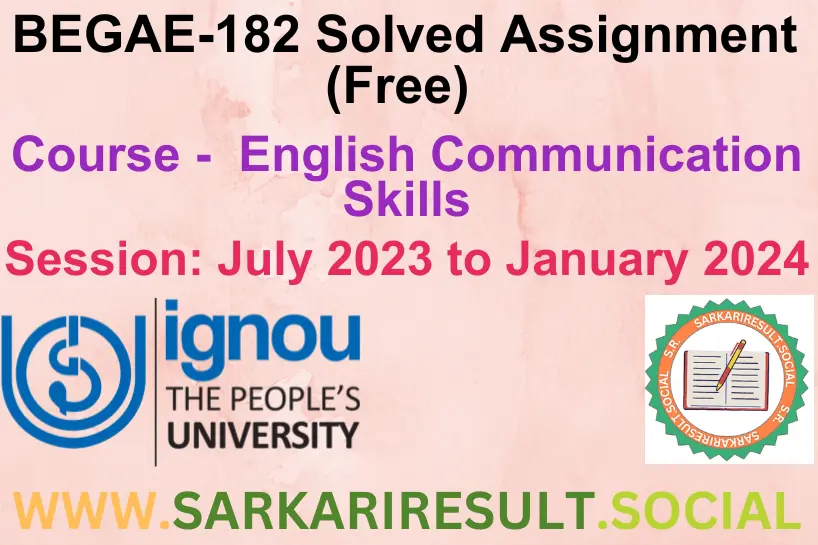
Table of Contents
Begae 182 IGNOU solved assignment 2023-24
“Looking for BEGAE 182 IGNOU solved assignment 2023-24 (Free) ? Master your English Communication Skills with our comprehensive and expertly crafted solved assignment . Score high marks in the Tutor Marked Assignment (TMA) carrying 100 marks. Our meticulously prepared solution ensures a critical analysis of the course material, enhancing your application skills. Follow the provided instructions to present a well-structured and concise response. Submit your neatly handwritten assignment before the Term End Examination to meet the submission deadline. Don’t miss this opportunity to excel! Get your IGNOU BEGAE-182 solved assignment now!”
Begae 182 Solved (Questions and Answers)
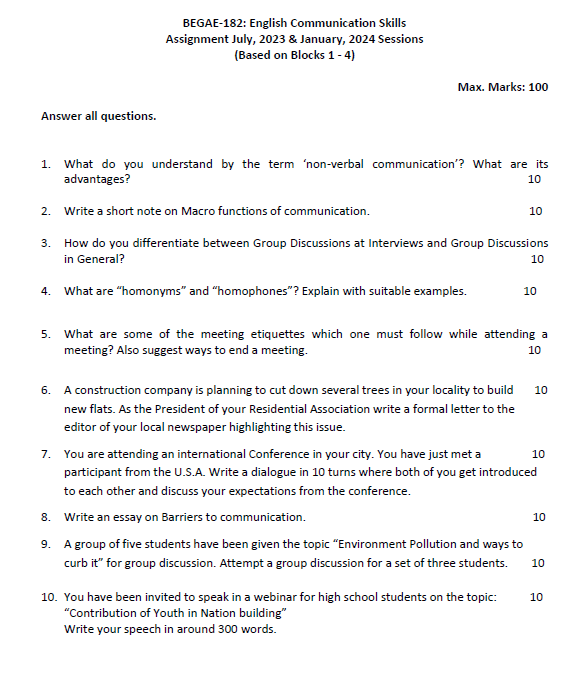
Q.1 What do you understand by the term ‘non-verbal communication’? What are its advantages?
Ans. Non-verbal communication is a way of expressing and understanding messages without using words. It involves using facial expressions, gestures, body movements, tone of voice, and even eye contact to convey thoughts and feelings. Imagine you’re watching a silent movie – the actors use their expressions and actions to tell a story without saying anything. Similarly, non-verbal communication adds meaning and depth to our conversations and interactions.
Advantages of non-verbal communication are like secret tools that help us connect with others and understand them better. Firstly, it helps us express emotions. When you smile, people know you’re happy; when you frown, they can tell you’re not pleased. These expressions let others know how you feel, even if you don’t say a word. Secondly, non-verbal cues enhance spoken words. Imagine saying “thank you” with a big smile – it makes your gratitude even more heartfelt. Thirdly, it helps us understand others. When someone crosses their arms, you might sense they’re feeling defensive or closed off. These signals guide us in figuring out what people really mean, beyond their words.
Moreover, non-verbal communication is like a language of its own. When you give a thumbs up, it means “good job!” without having to say it. This saves time and makes communication faster. Lastly, it can help build strong relationships. Good eye contact and friendly gestures show you’re interested and respectful, which helps people trust and like you.
In conclusion, non-verbal communication is a powerful way of expressing ourselves and understanding others. It adds meaning, emotion, and clarity to our conversations, making our interactions more genuine and enjoyable.
Q.2 Write a short note on Macro functions of communication.
Ans. The macro functions of communication are like the main reasons why we talk to each other. They help us achieve different goals when we communicate with others. Imagine communication as a toolbox, and these functions are like the tools we use to build better understanding and connections.
1. **Informative Function**: This is when we use communication to share information, facts, or ideas with others. It’s like giving someone directions or explaining how something works. For example, when a teacher teaches a lesson or you tell your friend about a cool fact, you’re using the informative function.
2. **Expressive Function**: Imagine communication as a way to show our feelings and thoughts. This function lets us share emotions and opinions. When you tell your family you’re excited about a trip or that you’re sad about something, you’re using the expressive function. It helps us express ourselves and connect emotionally.
3. **Directive Function**: Think of this as giving commands or guidance. When we communicate to tell someone what to do, like following instructions in a game or doing a task, we’re using the directive function. It helps us give and follow directions so things can be done correctly.
4. **Aesthetic Function**: This function adds a creative touch to communication. It’s like using words to create art or make things sound interesting. When you write a story, poem, or song that captures someone’s attention or makes them feel happy, you’re using the aesthetic function.
5. **Social Function**: Communication helps us make friends and connect with others. The social function is like a way to join a group or have a conversation. When you chat with your friends, share stories, or participate in a discussion, you’re using the social function. It helps us build relationships and feel like part of a community.
In short, these macro functions of communication are like different ways we use talking to achieve specific goals – like sharing information, expressing feelings, giving directions, being creative, and making friends. They help us communicate better and make our interactions more meaningful.
Q.3 How do you differentiate between Group Discussions at Interviews and Group Discussions in General?
Ans. Distinguishing between Group Discussions at Interviews and Group Discussions in General involves recognizing their distinct purposes, contexts, and expectations.
Group Discussions (GDs) at interviews are structured activities designed to assess a candidate’s communication skills, teamwork, and problem-solving abilities. In this specialized setting, individuals engage in conversations centered around specific topics or scenarios. The focus is on showcasing one’s knowledge, critical thinking, and ability to contribute constructively within a professional context. GDs at interviews are evaluative tools employed by employers to gauge a candidate’s suitability for a job role. Participants are assessed on their ability to communicate effectively, listen attentively, and collaborate seamlessly with others. The goal is to stand out positively while adhering to etiquette and presenting oneself as an ideal candidate.
On the other hand, Group Discussions in general refer to informal exchanges of ideas among a group of people. These discussions occur in various settings, such as classrooms, social gatherings, or problem-solving sessions. Unlike interview GDs, general GDs lack the formal assessment aspect and are primarily aimed at sharing opinions, brainstorming, or arriving at collective decisions. While effective communication is still crucial, there is no predetermined evaluation of individual performance. The emphasis is on exploring diverse viewpoints, engaging in open dialogue, and arriving at a consensus, if needed.
In summary, the distinction between Group Discussions at Interviews and Group Discussions in General lies in their objectives and contexts. Interview GDs serve as evaluation tools for job candidates, focusing on professional communication and problem-solving. General GDs, however, encompass informal exchanges of ideas, fostering open dialogue and collaborative decision-making without the evaluative component. Both types of discussions highlight effective communication skills, albeit within different frameworks.
Q.5 What are some of the meeting etiquettes which one must follow while attending a meeting? Also suggest ways to end a meeting.
Ans. Meeting etiquettes are important guidelines to ensure that meetings are conducted smoothly and effectively. Here are some key etiquettes one should follow while attending a meeting:
1. **Punctuality**: Arrive on time for the meeting. Being late can disrupt the flow and waste others’ time.
2. **Active Listening**: Pay attention to the speaker and avoid side conversations. Show that you’re engaged by nodding or taking notes.
3. **Respectful Communication**: Speak one at a time, avoid interrupting others, and use polite language.
4. **Stay On Topic**: Stick to the agenda and avoid discussing unrelated matters.
5. **Contribute Constructively**: Share your thoughts and ideas, but avoid dominating the conversation. Encourage others to participate as well.
6. **Silence Devices**: Silence or turn off your mobile phone and other devices to avoid distractions.
7. **Raise Hand**: If you want to speak or ask a question, raise your hand and wait to be acknowledged.
8. **Stay Seated**: Remain seated during the meeting unless you have a valid reason to move around.
9. **Follow the Chair’s Lead**: Respect the meeting leader’s decisions and guidance.
10. **Thank the Speaker**: After a presentation or when someone answers your question, express gratitude.
To end a meeting effectively, you can follow these steps:
1. **Summarize Key Points**: The meeting leader should recap the main decisions, discussions, and action items.
2. **Confirm Action Items**: Make sure everyone understands their responsibilities and deadlines for follow-up tasks.
3. **Open for Questions**: Allow participants to ask any final questions or seek clarifications.
4. **Express Gratitude**: Thank the attendees for their time, input, and participation.
5. **Set Next Steps**: Briefly outline when the next meeting will take place and any important updates.
6. **Adjourn the Meeting**: Officially close the meeting by thanking everyone and indicating that the meeting is over.
7. **Collect Feedback**: Encourage attendees to provide feedback on the meeting’s structure, content, and organization.
Remember, these etiquettes and ending steps help create a respectful and productive meeting environment, ensuring that everyone’s time is well-spent and objectives are met.
Q.6 A construction company is planning to cut down several trees in your locality to build new flats. As the President of your Residential Association write a formal letter to the editor of your local newspaper highlighting this issue.
Ans. [Your Name]
[Your Address]
[City, State, ZIP Code]
[Editor’s Name]
[Newspaper Name]
[Newspaper Address]
Subject: Concerns Regarding Tree Removal for Construction of New Flats
Dear [Editor’s Name],
I hope this letter finds you well. I am writing to express deep concerns on behalf of the residents of our locality, [Residential Association Name], regarding the impending decision by [Construction Company Name] to cut down several trees in our area for the construction of new flats. As the President of the [Residential Association Name], I believe it is my responsibility to bring this important matter to the attention of our community and seek a platform for discussion and awareness.
While we understand the need for urban development and expansion, it is vital to strike a balance between progress and preserving our natural environment. The trees that are slated for removal contribute immensely to the aesthetic appeal of our neighborhood and provide essential ecological benefits, such as improving air quality, providing shade, and supporting local biodiversity.
We strongly urge [Construction Company Name] to consider alternative approaches that would allow for the construction of new flats without sacrificing these valuable trees. Collaborative efforts between the construction company, local authorities, and community stakeholders can potentially yield innovative solutions that align with sustainable development practices.
Our Residential Association is committed to fostering a harmonious coexistence between modernization and environmental preservation. We believe that by raising awareness through your esteemed newspaper, we can encourage a constructive dialogue within our community and beyond. We kindly request your support in shedding light on this matter to ensure that the concerns of our residents are heard and that environmentally conscious decisions are made.
Thank you for your attention to this matter. We look forward to your assistance in generating public awareness and facilitating a meaningful discourse on this important issue.
[Your Name]
President, [Residential Association Name]
[Contact Information: Phone Number, Email Address]
Q.7 You are attending an international Conference in your city. You have just met a participant from the U.S.A. Write a dialogue in 10 turns where both of you get introduced to each other and discuss your expectations from the conference.
Ans. Participant A (You): Hi there! I’m attending the conference too. My name is Alex. Where are you from?
Participant B (U.S.A.): Hi Alex! I’m Sarah, and I’m from the United States. Nice to meet you!
Participant A: Nice to meet you too, Sarah! Is this your first time at this conference?
Participant B: Yes, it is! I’ve heard it’s a great opportunity to learn and meet people. How about you?
Participant A: This is my second time attending. Last year was really informative. I’m hoping to learn even more this time.
Participant B: That’s awesome! What are you most looking forward to learning about?
Participant A: I’m really interested in the workshops on sustainable technology. How about you? Any specific topics catching your attention?
Participant B: I’m excited about the sessions on cultural diversity and global communication. I think those will be really helpful for my work.
Participant A: Those sound interesting too. By the way, have you been able to explore our city a bit?
Participant B: Yes, I went to a few landmarks yesterday. The city is beautiful. How about you?
Participant A: I’ve been here for a while, so I know my way around. If you need any suggestions, feel free to ask.
Participant B: Thanks, Alex! That’s really kind of you. Oh, and are you planning to attend the evening networking event?
Participant A: Absolutely! It’s a great chance to connect with more people. Will you be there too?
Participant B: Yes, I’m looking forward to it. It was really nice meeting you, Alex. I’ll see you at the next session!
Participant A: Same here, Sarah! Have a great time at the conference. See you around!
Q.8 Write an essay on Barriers to communication.
Ans. Communication is a vital tool that helps people exchange ideas, thoughts, and information. However, sometimes communication encounters obstacles that hinder its effectiveness. These are known as barriers to communication. These barriers can occur in various forms and can affect both verbal and non-verbal communication.
One common barrier is language. When people speak different languages or have limited vocabulary, it becomes difficult to convey messages accurately. Misunderstandings can arise, leading to confusion. Another barrier is cultural differences. Different cultures have unique ways of expressing themselves, and what is considered polite in one culture might be offensive in another. This can lead to unintended conflicts or misunderstandings.
Physical barriers, such as distance or noise, can also impede communication. If someone is too far away to hear properly or if there’s too much noise in the environment, messages may not be effectively transmitted. Emotional barriers, like fear, shyness, or anger, can also affect communication. When people are afraid to speak up or are too upset to listen, effective communication becomes challenging.
Technology, while helpful, can also create barriers. Technical issues like poor phone connections or slow internet can disrupt communication. Moreover, relying solely on digital communication might miss out on the nuances of face-to-face interaction, leading to misunderstandings.
In conclusion, barriers to communication are hurdles that can hinder the smooth flow of information between individuals. These barriers can arise due to language differences, cultural variations, physical obstacles, emotional factors, or technological challenges. Being aware of these barriers and actively working to overcome them can lead to more effective and successful communication, promoting understanding and cooperation among people.
Q.9 A group of five students have been given the topic “Environment Pollution and ways to curb it” for group discussion. Attempt a group discussion for a set of three students.
Ans. Student A: Hi everyone, our topic for the group discussion is “Environment Pollution and ways to curb it.” I think this is a crucial issue we need to address. Pollution is harming our planet, and we must find solutions.
Student B: I totally agree, A. Pollution is getting worse, and it’s affecting our health and the planet’s well-being. We need to come up with practical ways to tackle this problem.
Student C: Yes, B, you’re right. One way to curb pollution is by reducing our use of plastic. Plastic waste is a major contributor to pollution, especially in oceans and water bodies.
Student A: I agree, C. We should all make an effort to use reusable bags, bottles, and containers. Another idea is to promote recycling and proper waste disposal.
Student B: Absolutely, A. And we should also focus on reducing air pollution. That means using cleaner sources of energy like solar and wind power, and using public transportation or carpooling to reduce vehicle emissions.
Student C: That’s a good point, B. We can also plant more trees and create green spaces in our communities. Trees help absorb harmful pollutants and improve air quality.
Student A: I think education is essential too. We need to raise awareness about the impact of pollution and ways to prevent it. We could organize workshops, seminars, or even school projects to spread the message.
Student B: Education is a powerful tool, A. And let’s not forget about conserving water. We should use water wisely at home and fix any leaks to prevent water pollution.
Student C: Right, B. Lastly, industries should adopt cleaner technologies and follow strict regulations to reduce pollution from factories and manufacturing processes.
Student A: Great discussion, everyone! We’ve covered some important ways to curb environment pollution: reducing plastic use, promoting recycling, using clean energy, planting trees, raising awareness, conserving water, and improving industrial practices.
Student B: Agreed, A. If we take these steps seriously, we can make a positive impact and help protect our environment for future generations.
Student C: I’m glad we had this discussion. It’s motivating to know that we can contribute to a cleaner and healthier planet by taking these actions.
[End of Group Discussion]
Q.10 You have been invited to speak in a webinar for high school students on the topic: “Contribution of Youth in Nation building” Write your speech in around 300 words.
Ans. Ladies and gentlemen, esteemed educators, and most importantly, the vibrant and enthusiastic youth joining us today, I am honored to address you on the topic of “Contribution of Youth in Nation Building.”
The youth, my fellow peers, are the cornerstone of any nation’s progress and development. As we stand at the cusp of shaping our collective future, it is imperative to recognize the immense potential that lies within each of us to contribute significantly to our nation’s growth.
First and foremost, the youth possess a fresh and innovative perspective. Our ability to think outside the box, challenge established norms, and embrace modern technologies allows us to drive change and advancement. We have the power to propose new ideas, champion sustainable practices, and foster a culture of adaptability.
Moreover, the energy and passion inherent in the youth can ignite a wave of positive transformation. Through active engagement in community service, volunteering, and social initiatives, we can address pressing issues such as education, healthcare, and environmental conservation. Small efforts can snowball into substantial impacts that ripple across society.
Education also plays a pivotal role in nation building. As we equip ourselves with knowledge and skills, we become future leaders, entrepreneurs, and professionals. By pursuing excellence in our chosen fields, we contribute to the nation’s intellectual and economic growth.
Furthermore, the youth are natural agents of social change. By raising awareness about crucial matters, advocating for justice and equality, and promoting tolerance and inclusivity, we pave the way for a more harmonious and united society.
In the age of digital connectivity, the youth have unparalleled platforms for amplifying their voices. Utilizing social media, we can engage in meaningful discussions, mobilize support for causes, and hold those in power accountable.
In conclusion, the contribution of youth in nation building cannot be overstated. Our fresh perspectives, unwavering enthusiasm, and dedication to positive change position us as catalysts for progress. Let us harness our potential to foster innovation, drive sustainable development, and create a brighter future for our nation. Remember, every action, no matter how small, has the power to leave an indelible mark on our nation’s tapestry. Together, we can be the architects of a prosperous and harmonious society. Thank you.
Q.4 What are “homonyms” and “homophones”? Explain with suitable examples.
Ans. “Homonyms” and “homophones” are linguistic terms that refer to words with similar sounds or spellings, but they have different meanings and uses. Let’s explore these concepts with clear examples to help you understand.
**Homonyms** are words that share the same spelling or pronunciation, but they have different meanings. These words can often cause confusion because their context determines their intended sense. For instance, the word “bat” can refer to a flying mammal or a piece of sports equipment used in baseball. Another example is “bark,” which can mean the sound a dog makes or the outer covering of a tree.
**Homophones**, on the other hand, are words that sound the same but have different meanings and spellings. These words can easily be confused when spoken, even though they are distinct in writing. For instance, “bare” means uncovered or naked, while “bear” refers to a large mammal. Similarly, “flower” is a beautiful plant, and “flour” is a powdery ingredient used in baking.
To remember the difference between homonyms and homophones, think of homonyms as words that share either their spelling or pronunciation, while homophones specifically refer to words that share only their pronunciation.
In summary, homonyms are words with the same spelling or pronunciation but different meanings, while homophones are words that sound the same but are spelled differently and have distinct meanings. Both concepts illustrate how the English language can be tricky due to words that appear or sound alike but carry different messages.
Similar Posts
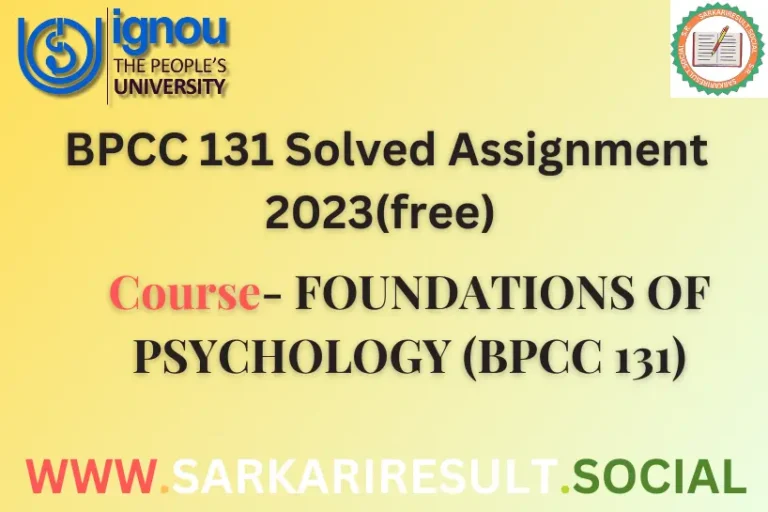
Check BPCC-131 IGNOU Solved Assignment 2023 (free) in best quality
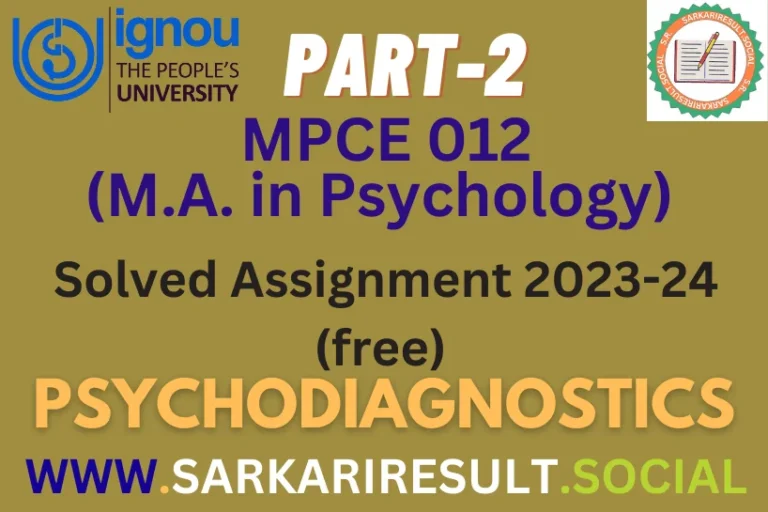
MPCE 012 IGNOU Solved Assignment 2023-24 (free) Part 2
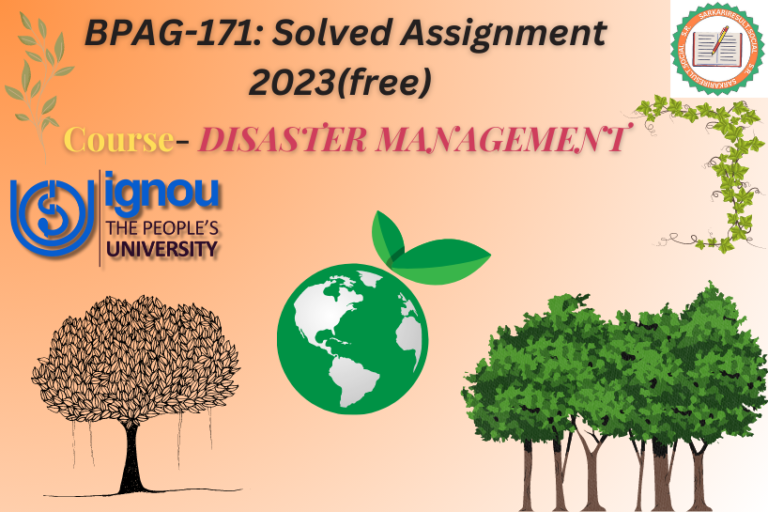
Check BPAG-171 IGNOU solved assignment 2022-2023 (free) before Last Date
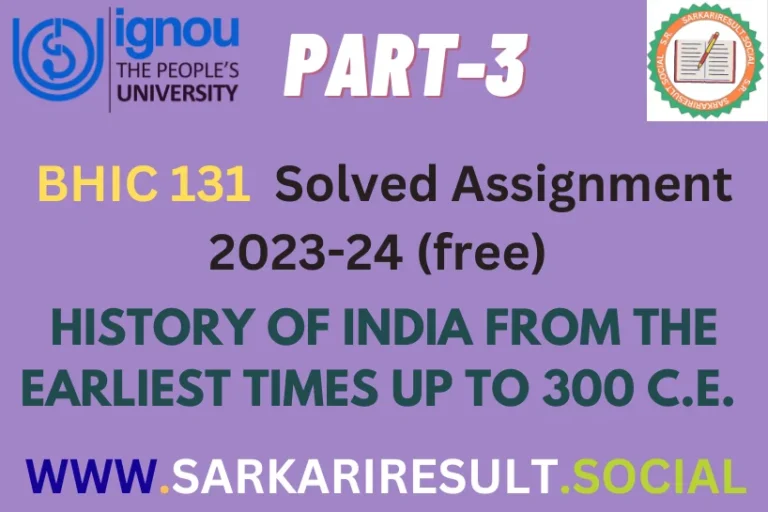
BHIC 131 IGNOU Solved Assignment 2023-24 (free) Part -3
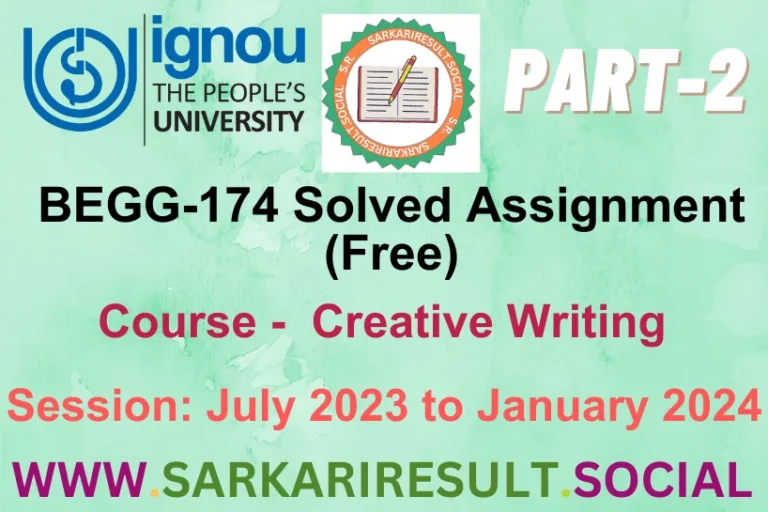
BEGG 174 SOLVED IGNOU ASSIGNMENT FREE PART 2
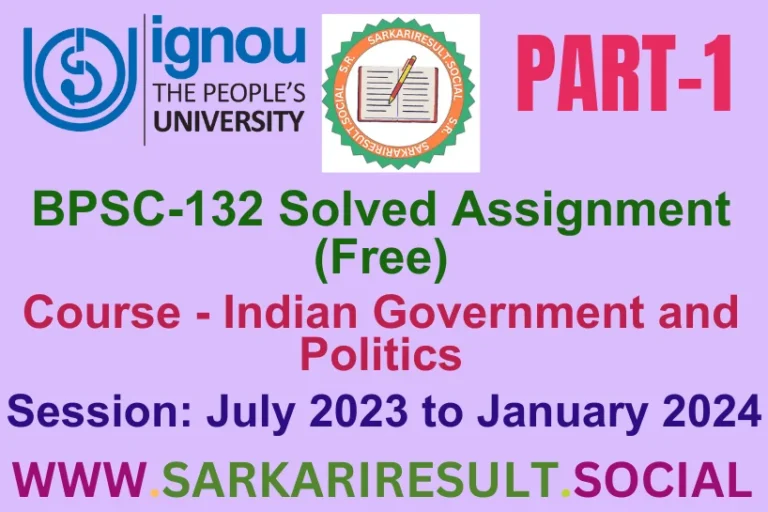
BPSC 132 SOLVED IGNOU ASSIGNMENT FREE PART 1
Leave a reply.
Your email address will not be published. Required fields are marked *
Ads Blocker Detected!!!
We have detected that you are using extensions to block ads. Please support us by disabling these ads blocker.
Only for Reading !!!

IGNOU BEGAE 182 SOLVED ASSIGNMENT 2023-24
- Post author: IGNOU ASSIGNMENT WALA
- Post published: April 7, 2024
- Post category: Solved Assignments
- Post comments: 0 Comments
BEGAE-182: English Communication Skills Assignment July, 2023 & January, 2024 Sessions (Based on Blocks 1 – 4) Max. Marks: 100 Answer all questions. 1. What do you understand by the term ‘non-verbal communication’? What are its advantages? 10 2. Write a short note on Macro functions of communication. 10 3. How do you differentiate between Group Discussions at Interviews and Group Discussions in General? 10 4. What are “homonyms” and “homophones”? Explain with suitable examples. 10 5. What are some of the meeting etiquettes which one must follow while attending a meeting? Also suggest ways to end a meeting. 10 6. A construction company is planning to cut down several trees in your locality to build 10 new flats. As the President of your Residential Association write a formal letter to the editor of your local newspaper highlighting this issue. 7. You are attending an international Conference in your city. You have just met a 10 participant from the U.S.A. Write a dialogue in 10 turns where both of you get introduced to each other and discuss your expectations from the conference. 8. Write an essay on Barriers to communication. 10 9. A group of five students have been given the topic “Environment Pollution and ways to curb it” for group discussion. Attempt a group discussion for a set of three students. 10 10. You have been invited to speak in a webinar for high school students on the topic: 10 “Contribution of Youth in Nation building” Write your speech in around 300 words.

You Might Also Like

IGNOU TS-4 ENGLISH SOLVED ASSIGNMENT 2021-22
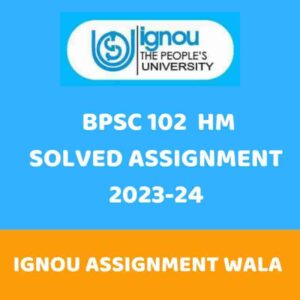
IGNOU BPSC 102 HINDI SOLVED ASSIGNMENT 2023-24
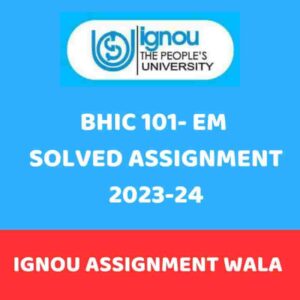
IGNOU BHIC 101 ENGLISH SOLVED ASSIGNMENT 2023-24
Leave a reply cancel reply.
You must be logged in to post a comment.
Chat on WhatsApp

- IGNOU CBCS BAG SOLVED ASSIGNMENT 2023-2024
- IGNOU CBCS BCOM(G) SOLVED ASSIGNMENT 2023-2024
- IGNOU CBCS BSC(G) SOLVED ASSIGNMENT 2022-2023
- IGNOU BA Hindi (BAHDH) SOLVED ASSIGNMENT
- IGNOU B.A English SOLVED ASSIGNMENT
- IGNOU B.A Sociology SOLVED ASSIGNMENT
- IGNOU B.A History SOLVED ASSIGNMENT
- IGNOU B.A Psychology SOLVED ASSIGNMENT
- IGNOU B.A Public Administration SOLVED ASSIGNMENT
- IGNOU B.A Political Science SOLVED ASSIGNMENT
- IGNOU BAECH (Economics) SOLVED ASSIGNMENT
- IGNOU B.A Philosophy SOLVED ASSIGNMENT
- IGNOU M.A Hindi SOLVED ASSIGNMENT
- IGNOU M.A English SOLVED ASSIGNMENT
- IGNOU M.A History SOLVED ASSIGNMENT
- IGNOU M.A Sociology SOLVED ASSIGNMENT
- IGNOU M.A Public Administration SOLVED ASSIGNMENT
- IGNOU M.A Political Science SOLVED ASSIGNMENT
- IGNOU M.A Psychology SOLVED ASSIGNMENT
- IGNOU M.A Economics SOLVED ASSIGNMENT
- IGNOU M.A RURAL DEVELOPMENT SOLVED ASSIGNMENT
- BCA 1st Semester
- BCA 2nd Semester
- BCA 3rd Semester
- BCA 4th Semester
- BCA 5th Semester
- BCA Question Papers
- Study Material
- Whatsapp Group
- RESULT TERM-END
- +919811854308

BEGAE-182 English Communication Skills Solved Assignment 2023-2024
DOWNLOAD NOW
Assignment July, 2023 & January, 2024 Sessions (Based on Blocks 1 – 4) Max. Marks: 100
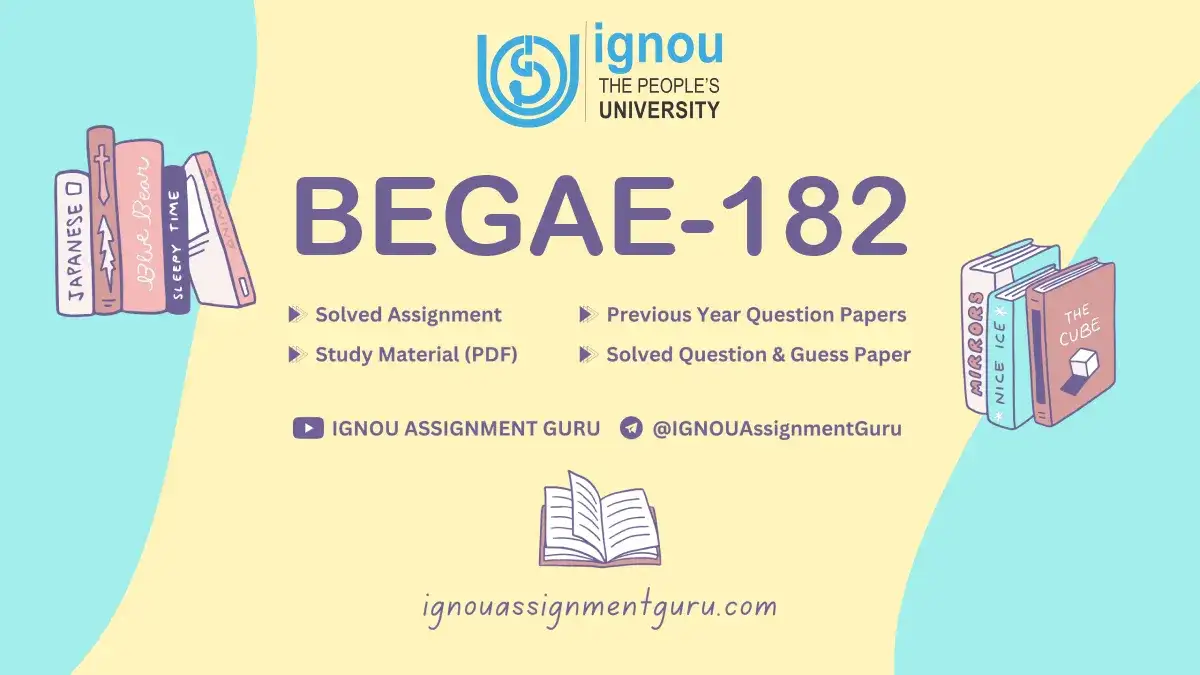
1. What do you understand by the term ‘non-verbal communication’? What are its advantages? 10 2. Write a short note on Macro functions of communication. 10 3. How do you differentiate between Group Discussions at Interviews and Group Discussions in General? 10 4. What are “homonyms” and “homophones”? Explain with suitable examples. 10 5. What are some of the meeting etiquettes which one must follow while attending a meeting? Also suggest ways to end a meeting. 10 6. A construction company is planning to cut down several trees in your locality to build 10 new flats. As the President of your Residential Association write a formal letter to the editor of your local newspaper highlighting this issue. 7. You are attending an international Conference in your city. You have just met a 10 participant from the U.S.A. Write a dialogue in 10 turns where both of you get introduced to each other and discuss your expectations from the conference. 8. Write an essay on Barriers to communication. 10 9. A group of five students have been given the topic “Environment Pollution and ways to curb it” for group discussion. Attempt a group discussion for a set of three students. 10 10. You have been invited to speak in a webinar for high school students on the topic: 10 “Contribution of Youth in Nation building” Write your speech in around 300 words.
The Advantages of studying IGNOU Solved Assignments are given below:
- Easy Accessibility: IGNOU solved assignments are easily accessible online, which means students can access them anytime and anywhere.
- Comprehensive Solutions: The solved assignments provide comprehensive answers to the questions asked in the assignments, which makes it easier for students to understand and study the topics.
- Cost-Effective: The solved assignments are available at a very economical rate, which makes them a great option for those who are on a budget.
- Reference Material: The solved assignments can be used as reference material for further study, as they provide detailed answers to the questions asked.
- Time-Saving: The solved assignments save a lot of time for students as they do not need to spend time researching and writing the answers themselves.
Can I score good marks by getting solved assignments?
Yes, you can get good marks by getting the Solved Assignment as it contains the answers to the questions asked in the assignment and will help you to understand the concepts better and score better.
Read more: How to Make IGNOU Solved Assignment?
RELATED ARTICLES MORE FROM AUTHOR
Mpce-046 applied positive psychology solved assignment 2023-2024, becc-108 मध्यवर्ती व्यष्टि-अर्थशास्त्र ॥ in hindi solved assignment 2023-2024, becc-107 अर्थशास्त्र के लिए साँख्यिकीय प्रविधियाँ in hindi solved assignment 2023-2024, leave a reply cancel reply.
Save my name, email, and website in this browser for the next time I comment.
- Terms & Condition
- Privacy Policy
- Refund & Cancellation
- Paid Solved Assignment
- privacy policy
- Terms and Conditions
- Refund policy
- +918504059601

- Study Materials
- _IGNOU BA/BDP
- Student Zone
- _HALL TICKETS
- _GRADE CARD
- _IGNOU ADMISSION
- _EXAM DATE-SHEET
- GUESS PAPERS
- SOLVED ASSIGNMENTS
- _NEW ASSIGNMENTS
- HANDWRITTEN ASSIGNMENT
- _MCA Handwritten copy
- _BCA Handwritten copy
Monday, November 20, 2023
Ignou begae-182 solved assignments 2023-24 session.
The introduction must tell you how to interpret the given topic and how you propose to develop it. The conclusion must summarize your views on the topic. Once you are satisfied with your answers. BEGAE-182, which will be a Tutor Marked Assignment (TMA) and will carry 100 marks

IGNOU BEGAE-182 SOLVED ASSIGNMENTS July- 2023-24
- IGNOU BAG English Solved Assignment
- IGNOU BAG More Solved Assignmen t
- IGNOU BAG Hindi Solved Assignment
BEGAE 182 Previous Year Question Paper Download in PDF, important questions from BEGAE-182 English Communication Skills, ASSIGNMENT SOLUTIONS GUIDE (2023-2024-2025). BEGAE – 182, ASSIGNMENT SOLUTIONS GUIDE (2022-2023). BEGAE - 182
IGNOU BEGAE-182 EXAM Notes and solved assignment questions Paper-1.
1. Write short notes on any four (150 words):
a) Verbal Communication
b) Essentials of a Good Group Discussion
c) Characteristics of a Good Communication
d) Homonyms and Homophones (with suitable examples)
e) Preferred techniques of Reading for understanding a text.
1. An International Conference is being organized by your institute. There are participants from different parts of the world. You happen to meet one such participant from London. Write a series of 8 (eight) dialogues exchanged between the two of you introducing yourself, your country and the socio-political situation of your countries during Pandemic.
2. Make a presentation on the topic (any one).
(i) Online Education
(ii) Education during Pandemic
(iii) Effect of Pollution on Health
(iv) Global Warming
1. How can one be an active participant in a meeting? Discuss some of the etiquettes that must be followed while attending a meeting.
2. List three recommendations on how a meeting should end and what should happen after a meeting.
3. Distinguish between ‘Silent Reading’ and ‘Reading aloud’. Also explain the two techniques of reading needed for the proper understanding of a text.
4. Explain the importance of shared assumptions between writer and reader.
5. What is meant by efficient Reading? What are the characteristics of reading?
6. A group of four students have been given the following topic for group discussion (any one)
(a) Climate Change
(b) Health & Pandemic
Write out the discussion giving at least 3 turns to each student.
IGNOU BEGAE-182 EXAM Notes and solved assignment questions Paper-2
1. What do you understand by the term ‘non-verbal communication’? What are its advantages?
2. Write a short note on Macro functions of communication.
3. How do you differentiate between Group Discussions at Interviews and Group Discussions in General?
4. What are “homonyms” and “homophones”? Explain with suitable examples.
5. What are some of the meeting etiquettes which one must follow while attending a meeting? Also suggest ways to end a meeting.
6. A construction company is planning to cut down several trees in your locality to build
new flats. As the President of your Residential Association write a formal letter to the editor of your local newspaper highlighting this issue.
7. You are attending an international Conference in your city. You have just met a
participant from the U.S.A. Write a dialogue in 10 turns where both of you get introduced to each other and discuss your expectations from the conference.
8. Write an essay on Barriers to communication.
9. A group of five students have been given the topic “Environment Pollution and ways to
curb it” for group discussion. Attempt a group discussion for a set of three students.
10. You have been invited to speak in a webinar for high school students on the topic:
“Contribution of Youth in Nation building” Write your speech in around 300 words.
IGNOU BEGAE-182 EXAM Notes and solved assignment questions Paper-3
1. What do you understand by the term ‘non-verbal communication’?
2. What are the conventions of a conversation? How does it differ from other speech events?
3. What is meant by the ‘schema theory’? How is it important in understanding the reading process?
4. Discuss any two difficulties that learners of English as a second language are likely to encounter while learning English vocabulary.
5. What are the four levels of meaning that you need to be aware of as a reader?
II. 1. You are attending an International Conference in your city. You have just met a participant from the U.S.A. Write out a dialogue in 10 turns where both of you get introduced to each other and discuss your expectations from the conference.
2. You have been invited to speak in a webinar for high school students on the topic:
“Challenges faced by school students in India during the COVID-19 lockdown.”
Write out your speech in around 250 words.
Section C
III. 1. Discuss the semantic and linguistic barriers to communication. Give suitable examples.
2. “Writing is commonly seen as a three-way process: pre-writing, writing and re-writing.” Explain this statement.
3. A group of four students have been given the following topic for group discussion. ‘Internet usage by school students: issues and challenges.”
Solutions Available Call/Whats app-+918504059601
THANKS®ARD
IGNOU HELP MASTER TEAM
WHATS APP NUMBER: +918504059601
ALL IGNOU SOLVED ASSIGNMENTS/HANDWRITTEN/EXAM GUESS PAPERS AVAILABLE
EMAIL:- IGNOUHELPMASTER @GMAIL.COM
No comments:
Post a comment, ignou exam help notes.
- IGNOU BAG Notes/guess Paper
- IGNOU MBA Exam Notes
IGNOU LATEST NEWS
- BCA Solved assignment 2024Session Click Here
- IGNOU M.A solved assignment2024 Session Click Here
- IGNOU BAG solved assignment 2024 Session Click Here
- MBA solved assignment 2024 Session Click Here
IGNOU SOLVED ASSIGNMENTS
- IGNOU PDF Assignments
- IGNOU Handwriting Assignments
- IGNOU Hard Copy Home delivery Assignments
- IGNOU Projects + synopsis
Popular Posts
- IGNOU New Students Whats App Groups new Students IGNOU All Students Whats App Free Links Join . The solve ignou students problem below, you get a list of active IGNOU Whats App groups cr...
- IGNOU Assignments Status || IGNOU Assignment Submit check Status IGNOU Assignment Submit check Status 2023-24 Indira Gandhi University (IGNOU) provides the ability to see the status of IGNOU assignments 2...
- IGNOU MCA New Free Solved Assignments 2023-24 Session IGNOU MCA Solved Assignments @20 Per subjects : If you were searching for the IGNOU MCA Semester Solved 2023-24 Session Assignment for 2023...
- IGNOU BAG Solved assignment July-2023 Session And January-2024 Session IGNOU BAG Solved Assignment For 2023-24 Session : If you were finding out the IGNOU BAG Semester solved Assignment for July-2023/Janu...
Breaking News
Fully Solved Assignments
SUPPORT STUDENTS
Blog archive.
IGNOU HELP MASTER
RAJASTHAN JHUNJHUNU-333029 Email id: ignouhelpmaster @gmail.com WhatsApp us: +918504059601

IGNOU BEGAE 182 Solved Assignment English Download 2023-2024
If you are on this page, you are looking for IGNOU BEGAE 182 Solved Assignment 2023–2024 Free Download and IGNOU BEGAE 182 Assignment Solutions in English and Hindi .
ASSIGNMENTS FOR IGNOU B AECH ARE NOW AVAILABLE FOR DOWNLOAD . IGNOU University’s New Session BAECH Program Assignment BAECH Student Assignment Questions can be downloaded from this page. Students must download compulsory assignments, with which they can take terms and exams.
To get good marks in the exam, Read Study Material and Solved The Assignment carefully With The Properly.
Important Note For Writing The BEGAE 182 Assignment.
- Write all the assignments with your own hand.
- Do not write to anyone else in a quick affair. This assignment can also be cancelled.
- The weight of IGNOU assignment is: 30% in total marks, so take this carefully
- Submit the assignment to the teacher of your learning center before due date.
- Use only foolscap size writing paper (but not of very thin variety) for writing your answers.
- Leave 4 cm margin on the left, top and bottom of your answer sheet.
- Your answers should be precise.
- Solve Part A, Part B and Part C of this assignment, and submit the complete assignment answer sheets within the due date.
IGNOU BEGAE-182 अंग्रेजी संचार Solved Assignment
Why download ignou begae-182 solved assignments.
Downloading IGNOU BEGAE 182 Solved Assignments can provide several benefits for students, including:
- Improved grades: IGNOU BEGAE 182 Solved Assignments provide students with a clear understanding of how to solve their assignments. By downloading and referring to these solved assignments, students can significantly improve their grades.
- Time-saving: Completing IGNOU BEGAE 182 assignments can be time-consuming. By downloading solved assignments, students can save time and focus on other academic and non-academic activities.
- Clear understanding: IGNOU BEGAE 182 Solved Assignments provide a clear understanding of the topic, making it easier for students to solve their assignments.
How to Download IGNOU BEGAE-182 Assignment Solutions ?
- Go to the download link of our page and click on it
- Choose Your Subject .
- Click On the Download Link.
- And Print or save PDF of study material in your phone or laptop.
Last Date of IGNOU BEGAE 182 Assignment Submission ?
- For July Session Admission : 15th April Session
- For Jan Session Admission : 15th October Session
No, you can’t download IGNOU BEGAE 182 Solved Assignments for free. You’ll need to purchase them from any of the websites listed above.
Yes, you can download IGNOU BEGAE 182 Solved Assignments for previous years from the websites listed above.
For July Session Admission : 15th April Session For Jan Session Admission : 15th October Session

BEGAE 182: English Communication Skills (BAG) Solved Assignment 2022-2023
- 1 Section A
- 2.1 a) Verbal Communication
- 2.2 b) Essentials of a Good Group Discussion
- 2.3 c) Characteristics of a Good Communication
- 2.4 d) Homonyms and Homophones (with suitable examples)
- 2.5 e) Preferred techniques of Reading for understanding a text.
- 3 Section B
- 4 1. An International Conference is being organized by your institute. There are participants from different parts of the world. You happen to meet one such participant from London. Write a series of 8 (eight) dialogues exchanged between the two of you introducing yourself, your country and the socio-political situation of your countries during Pandemic.
- 5.1 (i) Online Education
- 5.2 (ii) Education during Pandemic
- 5.3 (iii) Effect of Pollution on Health
- 5.4 (iv) Global Warming
- 6 Section C
- 7 1. How can one be an active participant in a meeting? Discuss some of the etiquettes that must be followed while attending a meeting.
- 8 2. List three recommendations on how a meeting should end and what should happen after a meeting.
- 9 3. Distinguish between ‘Silent Reading’ and ‘Reading aloud’. Also explain the two techniques of reading needed for the proper understanding of a text.
- 10 4. Explain the importance of shared assumptions between writer and reader.
- 11 4. What is meant by efficient Reading? What are the characteristics of reading?
- 12.1 (a) Climate Change
- 12.2 (b) Health & Pandemic
- 13.1 What is the due date for the BEGAE 182 English Communication Skills (BAG) Solved Assignment?
IGNOU BEGAE 182 Solved Assignment 2022-2023: It is an invaluable resource for students pursuing Bachelor’s Degree in Education (B.Ed) from Indira Gandhi National Open University (IGNOU). The course “Educational Evaluation and Assessment” (BEGAE 182) is a crucial part of the B.Ed program, and the solved assignment serves as a comprehensive guide for students to gain a deeper understanding of the subject. The assignment includes answers to all the questions provided in the study material and is designed to help students prepare for the term-end examination effectively.
The solved assignment has been created by experts in the field of education and assessment, ensuring that students receive accurate and up-to-date information. The solutions provided are concise and to-the-point, helping students grasp the concepts quickly. The assignment covers all the important topics of the course, such as educational evaluation, assessment of learning, measurement and evaluation, assessment of intelligence, and much more.
In addition to providing in-depth answers, the solved assignment also includes diagrams, charts, and tables to help students visualize the concepts better. The use of examples and real-life situations in the answers makes the assignment even more informative and practical. With the help of this solved assignment, students can improve their scores and secure a better grade in the term-end examination.
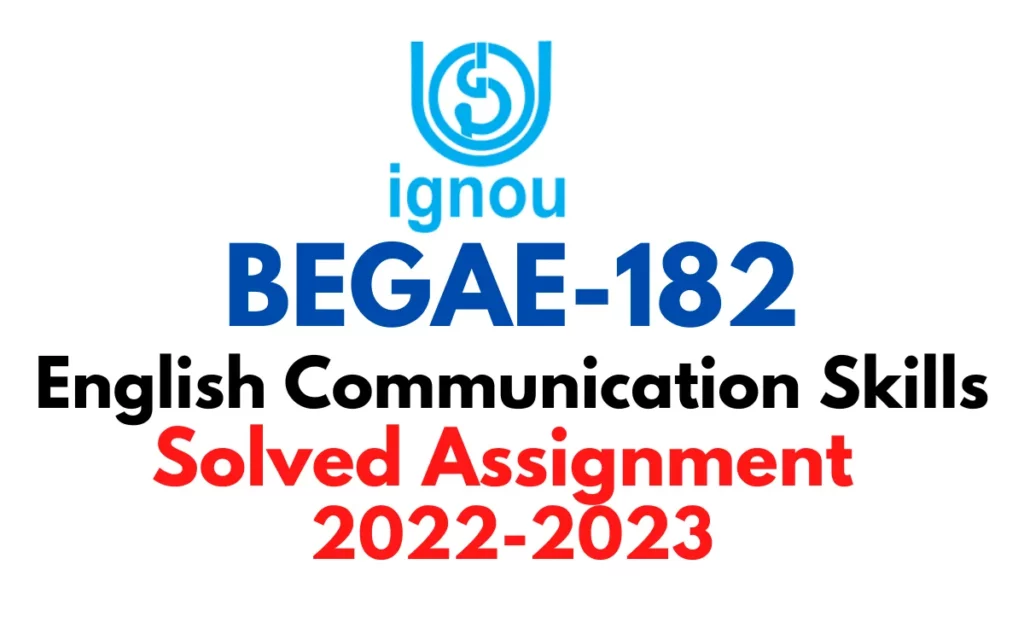
BEGAE-182: English Communication Skills Assignment July, 2022 & January, 2023 Sessions (Based on Blocks 1 – 4)
1. Write short notes on any four (150 words): (4 x 5 = 20)
A) verbal communication.
Answer: Verbal communication refers to the use of spoken or written words to convey a message. This type of communication can be formal or informal and can take place in a variety of settings, such as face-to-face, over the phone, or via video conferencing. Verbal communication is important because it allows individuals to express their thoughts and ideas, share information, and build relationships. However, it can also be subject to misinterpretation and can be influenced by factors such as tone of voice, body language, and cultural differences.

b) Essentials of a Good Group Discussion
Answer: A group discussion is a method of communication where a group of individuals come together to exchange ideas and reach a consensus on a particular topic. The essentials of a good group discussion include:
- Clear and defined objective: The group should have a clear understanding of the purpose and goal of the discussion.
- Participation: All members should actively participate in the discussion and express their opinions.
- Effective listening: Members should not only express their own ideas but also actively listen to the contributions of others.
- Respectful communication: Members should communicate in a respectful and non-judgmental manner.
- Inclusivity: The discussion should be inclusive and encourage participation from diverse perspectives.
- Time management : Adequate time should be allocated for the discussion, and the group should stay on topic to avoid getting sidetracked.
- Flexibility: The group should be open to new ideas and be willing to change their perspective if necessary.
- Summation: The group should summarize the key points discussed and reach a conclusion or decision.
c) Characteristics of a Good Communication
Answer: The characteristics of good communication include:
- Clarity: The message should be clear and easily understood by the intended audience.
- Conciseness: The message should be concise and to the point, avoiding unnecessary information or filler.
- Completeness: The message should be complete and provide all the necessary information.
- Correctness: The message should be accurate and free from errors.
- Empathy: The sender of the message should be aware of the perspective and emotions of the receiver.
- Feedback: The sender should be open to receiving feedback and be able to adjust the message accordingly.
- Timeliness: The message should be delivered at an appropriate time and in a timely manner.
- Adaptability: The message should be tailored to the audience and the specific situation.
- Confidentiality: The message should be kept confidential if it is intended to be private.
- Positive language: The message should be conveyed in a positive and constructive way, avoiding negative or inflammatory language.
d) Homonyms and Homophones (with suitable examples)
Answer: Homonyms are words that are spelled and pronounced the same way but have different meanings. For example:
- “Bass” (a type of fish) and “bass” (a low-frequency sound)
- “Tear” (to rip or to cry) and “tear” (a droplet of liquid from the eye)
Homophones are words that are pronounced the same way but have different spellings and meanings. For example:
- “Their” (possessive form of “they”) and “there” (in a place)
- “Hear” (to perceive sound) and “here” (in this place)
- “Brake” (to slow down) and “break” (to fracture)
It is important to be aware of homonyms and homophones in writing and speaking as they can cause confusion and lead to misinterpretation of the intended message.
e) Preferred techniques of Reading for understanding a text.
Answer: There are several preferred techniques that can be used to improve understanding when reading a text:
- Previewing: Skimming the text before reading it in detail, looking at the title, headings, subheadings, and any pictures or diagrams. This will give an idea of what the text is about and what to expect.
- Active reading: Engaging with the text by underlining, highlighting, or taking notes on key points as you read. This helps to focus attention and increase retention.
- Summarizing: After reading, summarizing the main ideas and key points in your own words. This will help to solidify understanding and make it easier to recall the information later.
- Questioning: Asking questions about the text, such as what is the main idea, what is the author’s purpose, and what are the key points. This will help to focus attention and deeper understanding.
- Reflecting: Thinking about the text and how it relates to your own experiences, knowledge, and beliefs. This will help to make connections and understand the text more fully.
- Following up: If necessary, looking up words or concepts that are unfamiliar, or researching more information on the topic. This will deepen understanding of the text.
- Re-reading: Re-reading the text, especially if you have difficulty understanding it. This can help to solidify understanding and uncover new insights.
1. An International Conference is being organized by your institute. There are participants from different parts of the world. You happen to meet one such participant from London. Write a series of 8 (eight) dialogues exchanged between the two of you introducing yourself, your country and the socio-political situation of your countries during Pandemic.
You: Hi, my name is [Your Name]. It’s nice to meet you.
Participant: Hi, Shubham. My name is Tom. Nice to meet you too.
You: So, where are you from?
Participant: I’m from London, England. How about you?
You: I’m from India. How do you like India so far?
Participant: It’s been great! I’ve only been here for a day, but I’m already enjoying the culture and the food.
You: I’m glad you’re enjoying your time here.
You: So, have you been following the news about the current socio-political situation in England?
Participant: I’ve seen some news about it, but I’m not too familiar with the details. Can you tell me more about it?
You: Sure. Recently, our country has been dealing with a lot of political turmoil, particularly related to [specific issue]. It’s been a challenging time, but we’re trying to stay positive and look towards the future.
You: How has the situation been in London and the UK?
Participant: It’s been difficult, like in most parts of the world. The pandemic has hit us hard, and we’ve had to implement strict measures to contain the spread. The economy has been affected, and many people have lost their jobs. But we’re trying to recover and come out stronger.
You: The pandemic has really affected us as well. We’ve had to implement strict measures to contain the spread, and it’s been tough on our economy. But we’re trying to stay positive and work together to get through it.
Participant: Yes, it’s definitely been a challenging time for everyone. But it’s important to remember that we’re all in this together, and we can support each other.
You: How has the pandemic affected your family and friends?
Participant: It’s been tough on them as well. Some of my friends have lost their jobs, and it’s been difficult for everyone to adjust to the new normal. But we’re trying to stay positive and support each other.
You: Yes, it’s definitely been a challenging time for everyone. But it’s important to stay positive and support each other. I’m glad we had a chance to talk.
Participant: Yes, it was nice to meet you and hear about the situation in your country. I hope we can continue to support each other during these difficult times.
2. Make a presentation on the topic:
(i) online education.
Answer: Title: “The Future of Education: Online Learning”
Introduction:
- The COVID-19 pandemic has accelerated the shift towards online education
- Online education offers many benefits such as flexibility, cost-effectiveness, and access to a wider range of course offerings
- In this presentation, we will explore the current state of online education, its advantages and disadvantages, and its potential impact on the future of education.
I. Current state of online education
- Online education has been around for decades, but has gained significant traction in recent years
- According to a report by the Online Learning Consortium, over 30% of higher education students took at least one online course in 2016
- Online education is not limited to higher education; K-12 schools and vocational training programs also offer online options
II. Advantages of online education
- Flexibility: Online education allows students to learn on their own schedule and at their own pace
- Cost-effectiveness: Online education can be less expensive than traditional in-person education, as it eliminates the need for transportation and housing
- Access to a wider range of course offerings: Online education allows students to take courses from institutions all over the world
- Convenience: Online learning can be done from anywhere with an internet connection.
III. Disadvantages of online education
- Lack of in-person interaction: Online education can be isolating, and students may miss out on the social and networking benefits of traditional education
- Self-motivation: Online education requires students to be self-motivated and disciplined to succeed
- Technical difficulties: Online education relies on technology, and technical issues can disrupt learning
- Quality of education: Some people argue that online education may not be as effective as traditional in-person education.
IV. Impact on the future of education
- Online education will continue to grow in popularity and become more mainstream
- Traditional institutions will likely incorporate more online elements into their curriculum
- Online education will make education more accessible to people in remote and underserved areas
- The rise of online education will also lead to changes in the way we think about accreditation and the value of a college degree.
Conclusion:
- Online education is a viable and increasingly popular option for students of all ages and backgrounds
- While there are some disadvantages to online education, its advantages make it a valuable addition to the education landscape
- Online education has the potential to democratize education and increase access to learning opportunities for people around the world.
Thank you for your attention.
(ii) Education during Pandemic
Answer: Title: “ Education in the Age of a Pandemic “
- The COVID-19 pandemic has brought about unprecedented changes to the education system
- From school closures to remote learning, educators and students have had to adapt to a new normal
- In this presentation, we will explore the challenges and opportunities presented by education during a pandemic, and the ways in which educators and students have risen to meet them.
I. Challenges of education during a pandemic
- School closures: The sudden shift to remote learning has been challenging for many students and educators, particularly those in underserved communities
- Lack of access to technology: Remote learning requires access to technology, and many students do not have the necessary equipment or internet access
- Mental health concerns: The pandemic has led to increased stress and anxiety, which can negatively impact students’ ability to learn
- Disruption to learning: The pandemic has disrupted the traditional academic calendar, leading to changes in curriculum and difficulty in assessing student progress.
II. Opportunities of education during a pandemic
- Flexibility: Remote learning allows for more flexibility in terms of scheduling and pacing
- Innovation: The need to adapt to remote learning has led to the development of new technologies and teaching methods
- Collaboration: Remote learning has emphasized the importance of collaboration between students, educators, and families
- Access to a wider range of resources: Remote learning has expanded access to educational resources and created new opportunities for global learning.
III. Best practices for educators during a pandemic
- Prioritizing student well-being: Educators should focus on supporting the mental and emotional well-being of students
- Incorporating technology: Educators should use technology to create engaging and interactive learning experiences
- Providing clear and consistent communication: Educators should keep in close contact with students and families to ensure everyone is on the same page
- Adjusting instruction: Educators should adjust their instruction to account for the disruptions caused by the pandemic.
IV. Best practices for students during a pandemic
- Setting a routine: Students should establish a consistent routine for remote learning
- Staying connected: Students should stay connected with their classmates and teachers through virtual platforms
- Managing stress: Students should practice stress management techniques such as mindfulness and exercise
- Seeking help: Students should seek help if they are struggling with remote learning or mental health concerns.
- The COVID-19 pandemic has presented a number of challenges and opportunities for education
- Educators and students have had to adapt to a new normal, but with the right approaches, they can continue to learn and grow
- It’s important to keep in mind the well-being of students, the importance of technology, clear communication, and the need to adjust instruction.
(iii) Effect of Pollution on Health
Answer: Title: “ The Impact of Pollution on Human Health “
- Pollution is a major environmental problem that affects the health and well-being of millions of people worldwide
- Pollution can come in many forms, including air pollution, water pollution, and soil pollution
- In this presentation, we will explore the effects of pollution on human health, the sources of pollution, and ways to reduce its impact.
I. The effects of pollution on human health
- Air pollution: Long-term exposure to air pollution can lead to a variety of health problems, including respiratory and cardiovascular disease, cancer, and stroke
- Water pollution: Exposure to contaminated water can lead to illnesses such as diarrhea, cholera, and typhoid fever
- Soil pollution: Exposure to polluted soil can lead to a range of health problems, including birth defects, cancer, and neurological disorders
- Noise pollution: Noise pollution can cause hearing loss, cardiovascular disease, sleep disturbance, and cognitive impairment.
II. Sources of pollution
- Air pollution: Common sources of air pollution include power plants, industrial facilities, and transportation
- Water pollution: Common sources of water pollution include industrial discharge, agricultural runoff, and sewage
- Soil pollution: Common sources of soil pollution include industrial activities, pesticides and fertilizers, and waste disposal
- Noise pollution: Common sources of noise pollution include transportation, construction, and industrial activities.
III. Ways to reduce the impact of pollution
- Individual actions: We can reduce our own impact on pollution by conserving energy, reducing waste, and using public transportation
- Government policies: Government policies such as stricter emissions standards and regulations on industrial activities can help reduce pollution
- Clean energy: Transitioning to clean energy sources such as solar and wind power can help reduce the impact of pollution
- Community action: Communities can come together to advocate for cleaner air and water and to reduce noise pollution.
IV. Conclusion
- The effects of pollution can be severe, and it is important to take action to reduce its impact
- By taking individual and collective actions, we can make a positive change and protect our health and the environment.
(iv) Global Warming
Answer: Title: “ Understanding Global Warming: Causes and Consequences “
- Global warming refers to the gradual increase in the Earth’s average surface temperature caused by human activities
- The main cause of global warming is the burning of fossil fuels, which releases greenhouse gases into the atmosphere
- In this presentation, we will explore the causes of global warming, its consequences, and what we can do to mitigate its effects.
I. Causes of Global Warming:
- Greenhouse gases: The burning of fossil fuels releases large amounts of greenhouse gases, such as carbon dioxide, into the atmosphere. These gases trap heat from the sun and warm the Earth’s surface
- Deforestation: Cutting down trees reduces the number of plants that absorb carbon dioxide from the atmosphere, contributing to global warming
- Industrial activities: Industries such as manufacturing and agriculture also release greenhouse gases and contribute to global warming
II. Consequences of Global Warming:
- Sea level rise: As the Earth’s temperature increases, ice melts and sea levels rise, which can cause flooding in coastal areas
- Extreme weather events: Global warming can cause more frequent and severe weather events such as heat waves, droughts, and hurricanes
- Loss of biodiversity: Changes in temperature and precipitation patterns can cause species to migrate or become extinct
- Food and water scarcity: Global warming can disrupt the growing season and lead to food and water shortages
III. Mitigating Global Warming:
- Reducing emissions: One of the most effective ways to slow down global warming is to reduce the amount of greenhouse gases we release into the atmosphere
- Renewable energy: Transitioning to clean energy sources such as solar, wind and hydro power can reduce greenhouse gas emissions
- Carbon sequestration: Trees, oceans, and other natural systems can absorb and store carbon dioxide, helping to mitigate the effects of global warming
- Energy efficiency: Improving energy efficiency in buildings and transportation can help reduce the amount of energy we use and greenhouse gas emissions
- Global warming is a complex and pressing issue that affects us all. The main cause of global warming is the burning of fossil fuels and the release of greenhouse gases into the atmosphere
- The consequences of global warming are severe and can have a big impact on our planet and our lives.
- We can take action to reduce our greenhouse gas emissions, shift to renewable energy, and protect our planet for future generations.
1. How can one be an active participant in a meeting? Discuss some of the etiquettes that must be followed while attending a meeting.
2. list three recommendations on how a meeting should end and what should happen after a meeting..
Being an active participant in a meeting involves several key behaviors:
- Preparation: Come to the meeting with a clear understanding of the agenda and any relevant materials. Make sure you have any necessary information or questions ready to contribute to the discussion.
- Participation: Speak up and share your thoughts and ideas during the meeting. Be respectful of others and listen actively to what others have to say.
- Focus: Stay focused on the topic at hand and avoid distractions, such as checking your phone or email.
- Follow-up: After the meeting, be sure to follow up on any action items or decisions that were made.
Some etiquettes that should be followed while attending a meeting include:
- Arrive on time: Being punctual shows respect for others’ time and sets a professional tone for the meeting.
- Dress appropriately: Dress in a way that is appropriate for the occasion and the company culture.
- Turn off electronic devices: To avoid distractions, turn off your phone or any other electronic devices that might interrupt the meeting.
- Respect others: Listen actively and avoid interrupting others when they are speaking.
- Avoid using slang or jargon: Using jargon or slang can be confusing to others and can make it difficult to understand the discussion.
- Be attentive: Avoid distractions like checking your phone or email, and stay focused on the topic at hand.
3. Distinguish between ‘Silent Reading’ and ‘Reading aloud’. Also explain the two techniques of reading needed for the proper understanding of a text.
Answer: Silent reading refers to reading a text without speaking or making any vocalizations. This type of reading is typically done alone and in a quiet environment. Silent reading allows the reader to focus on the text and comprehend the meaning without any distractions.
Reading aloud, on the other hand, refers to reading a text out loud, usually in front of others. This type of reading can be used for a variety of purposes, such as practicing pronunciation, improving fluency, or performing a play or speech. Reading aloud can also help with comprehension by allowing the reader to hear the words and understand the rhythm and tone of the text.
Two techniques of reading that are needed for proper understanding of a text are:
- Skimming: This technique involves quickly scanning the text to get an overview of the main ideas and key points. It helps to identify the purpose and main ideas of the text and also to decide whether it is worth reading in-depth.
- Scanning: This technique is used to find specific information within the text. It helps the reader to locate a specific piece of information, such as a date, name, or fact, quickly and efficiently.
Both skimming and scanning are useful for different purposes and can be used in conjunction with each other. Skimming can be useful for getting an overview of the text, while scanning can be used to find specific information. Together, they can help the reader to better understand and retain the information in the text.
4. Explain the importance of shared assumptions between writer and reader.
Shared assumptions refer to the beliefs, values, and background knowledge that both the writer and the reader bring to the text. These assumptions are important because they shape the way that the text is understood and interpreted. When the writer and the reader share similar assumptions, it can facilitate effective communication and understanding of the text.
For example, if a writer and a reader share the assumption that climate change is caused by human activity, the writer can use this assumption as a starting point in their text and the reader will likely understand and agree with the argument. If the reader does not share this assumption, it may lead to confusion or misunderstanding of the text.
Shared assumptions also allow the writer to use language and terminology that is familiar to the reader, making the text more accessible and easier to understand. In addition, shared assumptions can also help to establish common ground between the writer and the reader, which can facilitate effective communication and understanding.
4. What is meant by efficient Reading? What are the characteristics of reading?
Answer: Efficient reading refers to the ability to quickly and effectively understand and retain information from a text. This type of reading is characterized by the ability to scan and skim text to identify key information, as well as the ability to understand and interpret the meaning of the text.
The characteristics of efficient reading include:
- Speed: The ability to read quickly without sacrificing comprehension.
- Comprehension: The ability to understand and retain the information from the text.
- Focus: The ability to stay focused on the text and avoid distractions.
- Active reading: The ability to actively engage with the text by making connections, asking questions, and making predictions.
- Flexibility: The ability to adjust reading strategies depending on the type of text and purpose of reading.
- Skimming and scanning: The ability to quickly scan the text to identify key information and skim the text to get an overview of the main ideas.
- Critical thinking: The ability to evaluate and interpret the information in the text, rather than just accepting it as fact.
- Note-taking: The ability to take notes while reading, which can help with retention and understanding.
By developing and honing these characteristics, readers can improve their reading efficiency and better understand and retain the information from the text.
5. A group of four students have been given the following topic for group discussion .
(a) climate change.
Moderator: Alright, let’s begin our group discussion on climate change. Can each of you briefly introduce yourselves and share your initial thoughts on the topic?
Student 1: Hi, I’m Shubham. I think climate change is a serious issue that needs to be addressed as soon as possible.
Student 2: Hi, I’m Mohit. I agree with John, but I also think that it’s important to consider the economic impact of implementing measures to combat climate change.
Student 3: Hi, I’m Rohan. From my understanding, climate change is caused by human activity, specifically the burning of fossil fuels. I think it’s important for individuals and companies to reduce their carbon footprint.
Student 4: Hi, I’m Preeti. I think climate change is a complex issue that requires a multi-faceted approach. We need to consider not only reducing emissions, but also ways to adapt to the changes that are already happening.
Moderator: Great, thank you for your initial thoughts. Let’s dive deeper into the topic. Shubham, can you expand on why you think climate change is a serious issue?
Student 1: Sure. Climate change is causing rising sea levels, extreme weather events, and changes in precipitation patterns, all of which can have devastating consequences for human populations and ecosystems. Additionally, the burning of fossil fuels is also a major contributor to air pollution, which has negative impacts on human health.
Moderator: Mohit , can you expand on your thoughts about the economic impact of implementing measures to combat climate change?
Student 2: Sure. While investing in renewable energy and implementing measures to reduce emissions may have a short-term economic cost, in the long run it can lead to economic benefits such as job creation, energy independence, and reduced healthcare costs. Additionally, the cost of not addressing climate change, such as dealing with the impacts of extreme weather events and rising sea levels, can be even greater.
Moderator : Rohan, can you explain what you mean by reducing carbon footprint?
Student 3: Sure. A carbon footprint is the total amount of greenhouse gases that are emitted into the atmosphere as a result of human activities. This can include things like driving a car, using electricity from non-renewable sources, and industrial activities. Reducing our carbon footprint can involve things like using public transportation, using renewable energy sources, and conserving energy.
Moderator: Preeti, can you explain what you mean by a multi-faceted approach to combat climate change?
Student 4: Sure. In addition to reducing emissions, we also need to consider ways to adapt to the changes that are already happening. This can include things like building sea walls to protect against rising sea levels, developing drought-resistant crops, and creating early warning systems for extreme weather events. Additionally, it is important to consider the impact of climate change on vulnerable populations and to work towards climate justice.
Moderator: Great, thank you all for your insights. We’ve covered a lot of ground in this discussion, and it’s clear that climate change is a complex issue that requires a multifaceted approach. Let’s continue to work together to find solutions and make a difference.
(b) Health & Pandemic
Moderator: Alright, let’s begin our group discussion on Health & Pandemics. Can each of you briefly introduce yourselves and share your initial thoughts on the topic?
Student 1: Hi, I’m Rahul. I think that pandemics are a serious threat to public health and it’s important that we are prepared to handle them effectively.
Student 2: Hi, I’m Suraj. I agree with John, but I also think that it’s important to consider the social and economic impact of pandemics.
Student 3: Hi, I’m Pankaj. From my understanding, pandemics can spread quickly and cause widespread panic and fear. I think it’s important for governments and organizations to have clear and effective communication strategies in place.
Student 4: Hi, I’m Sahil. I think pandemics are a reminder that our global health systems need to be strengthened and more resilient in order to better respond to future outbreaks.
Moderator: Great, thank you for your initial thoughts. Let’s dive deeper into the topic. John, can you expand on why you think pandemics are a serious threat to public health?
Student 1: Sure. Pandemics can cause a large number of illnesses and deaths, and can also have a significant impact on healthcare systems, economies, and societies. Additionally, with the current ease of travel, pandemics can spread quickly across borders, making them a global concern. It’s important that we have plans in place to effectively detect, respond to, and control outbreaks to minimize their impact.
Moderator: Suraj, can you expand on your thoughts about the social and economic impact of pandemics?
Student 2: Sure. Pandemics can have a significant impact on society and the economy, including job loss, food shortages, and financial instability. Additionally, pandemics can also exacerbate existing social inequalities, disproportionately affecting vulnerable populations. It’s important to consider these broader impacts when developing pandemic response strategies.
Moderator: Pankaj, can you explain what you mean by clear and effective communication strategies in handling pandemics?
Student 3: Sure. Clear and effective communication is essential during a pandemic to ensure that the public is informed and understands the situation, as well as the actions that are being taken to control the outbreak. This can include things like providing accurate and up-to-date information on the number of cases and deaths, as well as the measures that are being taken to contain the outbreak. Additionally, it’s important to have clear guidance on how individuals can protect themselves and their communities.
Moderator: Sahil, can you explain what you mean by strengthening and making our global health systems more resilient?
Student 4: Sure. During pandemics, it is important to have strong and resilient health systems that can quickly detect and respond to outbreaks, as well as provide effective care to those who are affected. This includes having enough healthcare workers and facilities, as well as the necessary equipment and supplies. Additionally, it’s also important to invest in research and development to improve our ability to prevent, diagnose, and treat infectious diseases.
Moderator: Great, thank you all for your insights. We’ve covered a lot of ground in this discussion, and it’s clear that pandemics are a complex issue that requires a multifaceted approach. Let’s continue to work together to find solutions and make a difference.
What is the due date for the BEGAE 182 English Communication Skills (BAG) Solved Assignment?
The due date for the BEGAE 182 English Communication Skills (BAG) Solved Assignment will be provided by the course instructor. It is important to submit the assignment on or before the due date in order to receive full credit.
Related Posts:

Leave a Comment Cancel reply
Save my name, email, and website in this browser for the next time I comment.

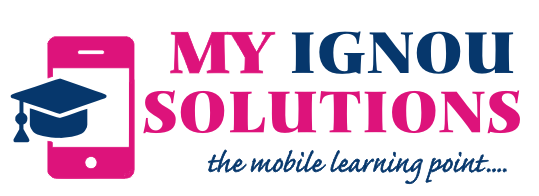
- IGNOU SOLVED ASSIGNMENT
- IGNOU STUDY MATERIAL
- IGNOU PREVIOUS PAPER
- IGNOU ADMIT CARD
BEGAE 182 Solved Assignment 2023-24
English Communication Skills
BEGAE 182 Solved Assignment 2023-24 : All assignments are in PDF format which would be send on email/WhatsApp (9958676204) just after payment.
Assignment Code: ASST/ BEGAE 182/2023-24
Attempt all the questions.
Q1) What do you understand by the term ‘non-verbal communication’? What are its advantages?
Non-verbal communication refers to the transmission of messages or information without the use of words. It involves the use of non-verbal cues, such as body language, facial expressions, gestures, postures, eye contact, and other forms of non-verbal signals. Non-verbal communication plays a crucial role in human interaction and can convey a wide range of emotions, attitudes, and intentions.
Expressiveness: Non-verbal cues can often convey emotions and attitudes more effectively than words alone. For example, a smile or a frown can instantly communicate happiness or displeasure.
Complementing Verbal Communication: Non-verbal cues can enhance and complement verbal messages. For instance, a speaker may use hand gestures to emphasize a point or make their message more engaging.
Conveying Cultural Nuances: Different cultures may have variations in non-verbal communication, and understanding these cues can help individuals navigate cross-cultural interactions more effectively.
Establishing Rapport: Non-verbal communication can contribute to the establishment of rapport and trust between individuals. Positive body language and appropriate gestures can create a sense of connection.
Clarifying Ambiguity: In situations where verbal communication may be unclear or ambiguous, non-verbal cues can provide additional context and help in interpreting the intended message.
Facilitating Feedback: Non-verbal cues provide immediate feedback to the speaker about how their message is being received. This allows for adjustments in communication to ensure better understanding.
Non-Verbal Cues are Universal: While language can be a barrier in cross-cultural communication, many non-verbal cues are universal to some extent. Facial expressions, for example, often convey similar emotions across different cultures.

Enhancing Persuasion: Non-verbal communication can be a powerful tool in persuasive communication. A confident posture, steady eye contact, and appropriate gestures can enhance the persuasiveness of a message.
Conveying Non-literal Messages: Non-verbal communication is often used to convey messages that go beyond the literal meaning of words. For example, a person may say they are fine verbally but their facial expressions and body language may indicate otherwise.
Saving Time: In some situations, non-verbal communication can convey a message more quickly and efficiently than verbal communication, particularly in emergencies or time-sensitive situations.
Understanding and being aware of non-verbal communication can significantly improve interpersonal skills and contribute to effective communication in various personal and professional settings.
Q2) Write a short note on Macro functions of communication.
Q3) How do you differentiate between Group Discussions at Interviews and Group Discussions in General?
Q4) What are “homonyms” and “homophones”? Explain with suitable examples.
Q5) What are some of the meeting etiquettes which one must follow while attending a meeting? Also suggest ways to end a meeting.
Q6) A construction company is planning to cut down several trees in your locality to build 10 new flats. As the President of your Residential Association write a formal letter to the editor of your local newspaper highlighting this issue.
Q7) You are attending an international Conference in your city. You have just met a participant from the U.S.A. Write a dialogue in 10 turns where both of you get introduced to each other and discuss your expectations from the conference.
Q8) Write an essay on Barriers to communication.
Q9) A group of five students have been given the topic “Environment Pollution and ways to curb it” for group discussion. Attempt a group discussion for a set of three students.
Q10) You have been invited to speak in a webinar for high school students on the topic:
“Contribution of Youth in Nation building” Write your speech in around 300 words.
BEGAE 182 Solved Assignment 2023-24, BEGAE 182 Solved Assignment 2023-24, BEGAE 182 Solved Assignment 2023-24, BEGAE 182 Assignment, IGNOU Assignment BEGAE 182 2023-24- Gandhi National Open University had recently uploaded the assignments of the present session for Programme for the year 2023-24. BEGAE 182 Solved Assignment 2023-24 Students are recommended to download their Assignments from this web page itself. They don’t got to go anywhere else when everything regarding the Assignments are available during this article only.
For Students - BEGAE 182 Solved Assignment 2023-24 Students are advised that after successfully downloading their Assignments, you'll find each and each course assignments of your downloaded Programme. BEGAE 182 Solved Assignment 2023-24 Candidates need to create separate assignment for the IGNOU Master Course, in order that it's easy for Evaluators to see your assignments.
IGNOU Assignment Status 2023-24
IGNOU BEGAE 182 Solved Assignment 2023-24 once the TEE assignments are submitted to the Centres, it's send to the evaluation department. After which the evaluation of IGNOU Assignment Solutions takes place.
IGNOU BEGAE 182 Solved Assignment 2023-24 :- Those students who had successfully submitted their Assignments to their allocated study centers can now check their Assignment Status. Alongside --assignment status, they will also checkout their assignment marks & result. All this is often available in a web mode. After submitting the assignment, you'll check you BEGAE 182 Solved Assignment 2023-24 only after 3-4 weeks. BEGAE 182 Solved Assignment 2023-24 it'd take 40 days to declare BEGAE 182 Solved Assignment 2023-24
For IGNOU Solved Assignment PDF & Hand Written
Subscribe YouTube : My IGNOU Solutions
WhatsApp Contact : 9958676204
You may like these posts
Popular posts.

The Nature of State and Sovereignty in Ancient India

Discuss the relationship between education and politics

Describe the main features of modern political theory
Featured post.
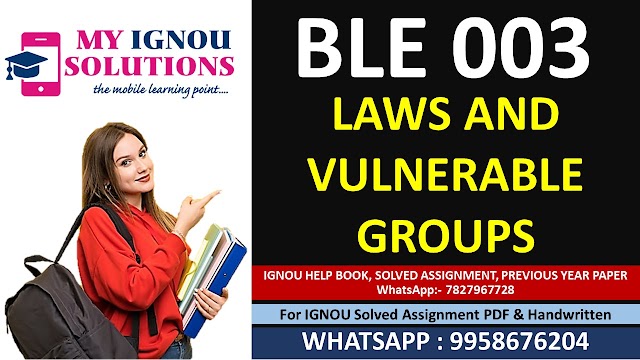
BLE 003 Solved Assignment 2024-25
BLE 003 Solved Assignment 2024-25 LAWS AND VULNERABLE GROUPS BLE 003 Solved Assi…
Subscribe Us
Popular Post

MEG 07 Solved Assignment 2022-23

MEG 05 Solved Assignment 2022-23

Fascist World view
- IGNOU RESULT
Menu Footer Widget
- Contact 9891268050
- IGNOU Handwritten Assignments
- IGNOU GUESS PAPER SOLVED
- IGNOU SOLVED ASSIGNMENT

- All APPLICATION 2020-21 ASSIGNMENT COMBO 2021-22 B.COM | ECO | BCOE 2021-22 B.SC | MTE | CHE | LSE | PHE BA | BCOM | BSC CBCS 2021-22 BA | BCOM | BSC| CBCS SOLVED ASSIGNMENT 2023-24 BA SOLVED ASSIGNMENT 2023-24 COMBO BABG 2021-22 BAECH ASSIGNMENT {2020-21} BAEGH ASSIGNMENT 2020-21 BAEGH ASSIGNMENT 2021-22 BAG | BCOMG | BSG SOLVED ASSIGNEMNT 2019-20 BAG | BCOMG | BSG SOLVED ASSIGNEMNT 2020-21 BAG 2021 BAG SOLVED ASSIGMENT 2021.22 BAHDH ASSIGNMENT 2020-21 BAHIH 2020 ASSIGNMENT BAHIH SOLVED ASSIGMENT 2021-22 BAHIH Solved assignment {2020-21} BANC 2021-22 BANE 2021-22 BANS 2021-22 BAPAH ASSIGNMENT 2020-21 BAPAH ASSIGNMENT 2021-22 BAPCH ASSIGNMENT 2020-21 BAPCH ASSIGNMENT 2021-22 BAPSH ASSIGNMENT 2020-21 BAPSH SOLVED ASSIGMENT 2021.22 BASOH ASSIGNMENT 2020-21 BASOH ASSIGNMENT 2021.22 BAVTM SOLVED ASSIGMENT 2021.22 BAVTM SOLVED ASSIGNMENT 2020-21 BCA | MCA | 2020-21 BCA | MCA | 2021.22 BCOC 2021-22 BCOMG SOLVED ASSIGMNET 2021.22 BCOMG SOLVED ASSIGNMENT {2020-21} BCOS 2021-22 BDP | FOUNDATION 2021-22 BECC 2021-22 BED 2019 BEGE | BA English BEGE | BA English | 2020-21 BLIS | BLIE | BA BLIS | BLIE | BA | 2020 BLIS | BLIE | BA Library Science 2020-21 BLIS | BLIE | BA Library Science 2021-22 BPC | BPCE | BA Psychology BPC | BPCE | BA Psychology | 2020-21 BPY | BPY | Philosophy | 2020-21 BSC| MTE | CHE | LSE | PHE 2022 BSCANH ASSIGNMENT 2020-21 BSCANH SOLVED ASSIGMENT 2021.22 BSCG 2021 BSCG SOLVED ASSIGNMENT {2020-21} BSCG SOLVED ASSIGNMENT 2021.22 BSW | BSWE | BA Social Work 2020-21 BSWE | BA Social BSWG SOLVED ASSIGMENT 2021-22 CLIS 2021.22 DECE | 2020 DNHE 2022 DNHE-2020 ECO | B.COM ECO SOLVED ASSIGNMENT 2020-21 EEC | BECE | ECONOMICS EEC | BECE SOLVED 2021-22 EHD | BHDE | BA Hindi EHD | BHDE | BA Hindi | 2020-21 EHD | BHDE BA Hindi 2021-22 EHI | BHIE | BA History EHI | BHIE | BA History | 2020-21 EHI | BHIE | BA History | 2021-22 EPA | BPAE | BA Public EPA | BPAE | BA Public | 2020-21 EPA | BPAE | BA Public | 2021-22 EPS | BPSE | BA EPS | BPSE | BA | 2020-21 EPS | BPSE | BA | 2021-22 ESO | SOCIOLOGY ESO | SOCIOLOGY | 2020-21 ESO | SOCIOLOGY 2021-22 FOUNDATION FOUNDATION | 2020-21 IBO | MCO | MCOM {2019-20} IBO | MCO | MCOM | 2020-21 IBO | MCO | MCOM | 2021.22 IBO | MCO | MCOM | COMBO IBO | MCO | MCOM | COMBO 2020-21 IGBOU BBA Previous Year Solved Question Paper IGNOPU BAHDH SOLVED ASSIGNMENT 2023-24 IGNOU ACISE Solved Assignment July 2023 IGNOU B.ED | BES SOLVED ASSIGNMENT 2022 IGNOU BAAHD SOLVED ASSIGNMENT 2023-24 IGNOU BAASK SOLVED ASSIGNMEMT 2023-24 IGNOU BAAUD SOLVED ASSIGNMENT 2023-24 IGNOU BAECH ASSIGNMENT 2023-24 IGNOU BAECH SOLVED ASSIGMENT 2021-22 IGNOU BAECH Solved Assignment 2023-24 IGNOU BAECH Solved Guess Paper IGNOU BAEGH Previous Year Solved Question Paper IGNOU BAEGH Solved Assignment 2023-24 IGNOU BAFHI Solved Assignment January & July 2024 IGNOU BAFSM SOLVED ASSIGMENT 2023 IGNOU BAFSM Solved Assignment 2024 IGNOU BAG Previous Year Solved Question Paper IGNOU BAG SOLVED ASSIGNMENT 2023-24 IGNOU BAG SOLVED ASSIGNMENT 2024 IGNOU BAG Solved Guess Paper IGNOU BAGS SOLVED ASSIGMENT 2023 IGNOU BAGS SOLVED ASSIGNMENT 2023-24 IGNOU BAHDH ASSIGNMENT 2021-22 IGNOU BAHDH Previous Year Solved Question Paper IGNOU BAHDH SOLVED ASSIGNMENT 2023 IGNOU BAHDH SOLVED ASSIGNMENT 2023-24 IGNOU BAHIH | BHIC SOLVED ASSIGNMENT 2023-24 IGNOU BAHIH Previous Year Solved Question Paper IGNOU BAPAH | BPAC SOLVED ASSIGNMENT 2023-24 IGNOU BAPAH Previous Year Solved Question Paper IGNOU BAPCH Previous Year Solved Question Paper IGNOU BAPCH SOLVED ASSIGNMENT 2023-24 IGNOU BAPSH Previous Year Solved Question Paper IGNOU BAPSH Solved Assignment 2023-24 IGNOU BAPSH Solved Guess Paper IGNOU BASKH Solved Assignment 2023-24 IGNOU BASOH Previous Year Solved Question Paper IGNOU BASOH SOLVED ASSIGNMENT 2023-24 IGNOU BATS SOLVED ASSIGNMENT 2023-24 IGNOU BAUDH Solved Assignment 2023-24 IGNOU BAVTM SOLVED ASSIGNMENT 2023-24 IGNOU BBA SOLVED ASSIGNMENT 2023-24 (General) IGNOU BBA SOLVED ASSIGNMENT 2023-24 Retail (OLD) IGNOU BBA Solved Guess Paper IGNOU BBA-RETAIL (NEW) Solved Assignment 2023-24 IGNOU BCA SOLVED ASSIGNMENT 2023-24 IGNOU BCOM SOLVED ASSIGNMENT 2023-24 (BDP) IGNOU BCOM SOLVED GUESS PAPER IGNOU BCOMG Previous Year Solved Question Paper IGNOU BCOMG SOLVED ASSIGNMENT 2023-24 IGNOU BDP Previous Year Solved Question Paper IGNOU BDP SOLVED ASSIGNMENT 2023-24 IGNOU BDP Solved Guess Paper IGNOU BED Previous Year Solved Question Paper IGNOU BED Solved Assignment 2023-24 IGNOU BED Solved Guess Paper IGNOU BES Solved Guess Paper IGNOU BHIH Previous Year Solved Question Paper IGNOU BLIS | BLIE SOLVED ASSIGNMENT 2023-24 IGNOU BLIS Previous Year Solved Question Paper IGNOU BLIS SOLVED GYESS PAPER IGNOU BSCANH Previous Year Solved Question Paper IGNOU BSCANH Soled Guess Paper IGNOU BSCANH SOLVED ASSIGNMENT 2023-24 IGNOU BSCG Previous Year Solved Question Paper IGNOU BSCG Soled Guess Paper IGNOU BSCG SOLVED ASSIGNMENT 2023-24 IGNOU BSCG SOLVED ASSIGNMENT 2024 IGNOU BSEG Previous Year Solved Question Paper IGNOU BSW SOLVED ASSIGNMENT 2023-24 IGNOU BSWE Previous Year Solved Question Paper IGNOU BSWE SOLVED GYESS PAPER IGNOU BSWG SOLVED ASSIGNMENT 2023-24 IGNOU BTS Previous Year Solved Question Paper IGNOU BTS SOLVED ASSIGNMENT 2023 IGNOU BTS SOLVED ASSIGNMENT 2024 IGNOU CAFE Solved Assignment Jan & July 2023 IGNOU CAHT Solved Assignment January & July 2024 IGNOU CBKG Solved Assignment 2023 IGNOU CCP | CPI SOLVED ASSIGNMENT 2023 IGNOU CCP Solved Assignment Jan & July 2024 IGNOU CDM Solved assignment 2024 IGNOU CEDE JULY 2023 SOLVED ASSIGNMENT IGNOU CETM SOLVED ASSIGNMENT 2023 IGNOU CFDE | BFDI SOLVED ASSIGNMENT 2023 IGNOU CFN Previous Year Solved Question Paper IGNOU CHCWM SOLVED ASSIGNMENT 2023 IGNOU CHCWM Solved Assignment January 2024 IGNOU CHR SOLVED ASSIGNMENT 2023 IGNOU CIG Solved Assignment January & July 2024 IGNOU CIS SOLVED ASSIGNMENT JAN-JULY 2023 IGNOU CIT SOLVED ASSIGNMENT 2023-24 IGNOU CLIS Previous Year Solved Question Paper IGNOU CLIS Solved Assignment January & July 2024 IGNOU CLTA SOLVED ASSIGNMENT 2023-24 IGNOU CNCC Previous Year Solved Question Paper IGNOU CNCC SOLVED ASSIGNMENT JAN 2023 JULY 2023 IGNOU CNM SOLVED ASSIGNMENT 2023 IGNOU COF Previous Year Solved Question Paper IGNOU COF Solved Assignment January & July 2024 IGNOU CPDT SOLVED ASSIGNMENT 2023 IGNOU CPDT SOLVED ASSIGNMENT 2024 IGNOU CPSCM Solved Assignment 2023-24 IGNOU CPY SOLVED ASSIGNMENT JULY 2023 IGNOU CPY SOLVED ASSIGNMENT JULY 2024 IGNOU CRD/CRDOL Revised solved assignment 2023-24 IGNOU CSWATT Solved Assignment January 2024 IGNOU CSWM SOLVED ASSIGMENT July 2023 IGNOU CTE SOLVED ASSIGNMENT 2023-24 IGNOU CTRBS Solved Assignment 2023-24 IGNOU CTS SOLVED ASSIGNMENT 2024 IGNOU CWHM Previous Year Solved Question Paper IGNOU CWHM SOLVED ASSIGNMENT Jan 2024 IGNOU DAFE Solved Assignment Jan & July 2023 IGNOU DECE 2022 SOLVED ASSIGMENT IGNOU DECE Previous Year Solved Question Paper IGNOU DECE SOLVED ASSIGNMENT 2023 IGNOU DEVMT Previous Year Solved Question Paper IGNOU DEVMT Solved Assignment 2023-24 IGNOU DHORT SOLVED ASSIGNMENT 2023 IGNOU DNHE Previous Year Solved Question Paper IGNOU DNHE Solved Assignment Jan & July 2024 IGNOU DPLAD Solved Assignment 2023-24 IGNOU DTS SOLVED ASSIGNMENT 2023 IGNOU DTS SOLVED ASSIGNMENT 2024 IGNOU DWM Solved Assignment 2024 IGNOU IGNOU PGDIDM Solved Assignment July 2023 IGNOU MA Education Previous Year Solved Question Paper IGNOU MAAN Previous Year Solved Question Paper IGNOU MAAN SOLVED ASSIGNMENT 2023-24 IGNOU MAAN Solved Guess Paper IGNOU MACSR SOLVED ASSIGNMENT 2023-24 IGNOU MADE Solved Assignment January & July 2024 IGNOU MADJ SOLVED ASSIGNMENT Jan & July 2023 IGNOU MADJ Solved Assignment January & July 2024 IGNOU MADVS | MRD SOLVED ASSIGNMENT 2022-23 IGNOU MADVS SOLVED ASSIGNMENT 2023-24 IGNOU MAE Previous Year Solved Question Paper IGNOU MAEC SOLVED ASSIGNMENT 2023-24 IGNOU MAEDU SOLVED ASSIGNMENT January & July 2023 IGNOU MAEDU Solved Assignment January & July 2024 IGNOU MAEDU Solved Guess Paper IGNOU MAEOH Solved Assignment 2024-25 IGNOU MAER Solved Assignment 2023-24 IGNOU MAFCS SOLVED ASSIGNMENT 2023-24 IGNOU MAFL SOLVED ASSIGNMENT 2023-24 IGNOU MAFL SOLVED ASSIGNMENT JAN 2023 IGNOU MAGD SOLVED ASSIGNMENT 2023-24 IGNOU MAGPS Solved Assignment 2023-24 IGNOU MAH | MHI SOLVED ASSIGNMENT 2023-24 IGNOU MAH Previous Year Solved Question PaperV IGNOU MAHI Solved Assignment 2023-24 IGNOU MAJDM solved assignment July 2023 IGNOU MAJEM solved assignment Jan & July 2024 IGNOU MAJMC Previous Year Solved Question Paper IGNOU MAJMC Solved Assignment 2024 IGNOU MAJMC Solved Assignment Jan & July 2024 IGNOU MAJMC Solved Assignment July 2023 IGNOU MAJY Solved Assignment 2023-24 IGNOU MAMIDI Solved Assignment 2023-24 IGNOU MAPC Previous Year Solved Question Paper IGNOU MAPC Solved Assignment 2023-24 IGNOU MAPY Solved Assignment 2023-24 IGNOU MAPY Solved Guess Paper IGNOU MARD Previous Year Solved Question Paper IGNOU MARD Solved Assignment 2023-24 IGNOU MATS Solved Assignment Jan & July 2023 IGNOU MAUS SOLVED ASSIGNMENT 2023-24 IGNOU MAWGS Solved Assignment 2023-24 IGNOU MAWGSR SOLVED ASSIGNMENT 2023-24 IGNOU MBA Previous Year Solved Question Paper IGNOU MBA SOLVED ASSIGNMENT 2023-24 (2024) IGNOU MBA Solved Guess Paper IGNOU MCA Solved Assignment 2023-24 IGNOU MCFT Previous Year Solved Question Paper IGNOU MCOM Previous Year Solved Question Paper IGNOU MCOM SOLVED ASSIGMENT 2023-24 (New) IGNOU MCOM SOLVED ASSIGNMENT 2023-24 (Old) IGNOU MCOM Solved Guess Paper IGNOU MCS SOLVED ASSIGNMENT 2023-24 IGNOU MCS/BCS Previous Year Solved Question Paper IGNOU MEC Previous Year Solved Question Paper IGNOU MEC SOLVED ASSIGNMENT 2023-24 IGNOU MEC Solved Guess Paper IGNOU MEG Previous Year Solved Question Paper IGNOU MEG SOLVED ASSIGNMENT 2023-24 IGNOU MGPS Previous Year Solved Question Paper IGNOU MHD Previous Year Solved Question Paper IGNOU MHD SOLVED ASSIGNMENT 2023-24 IGNOU MLIS Previous Year Solved Question Paper IGNOU MLIS SOLVED ASSIGNMENT 2023-24 IGNOU MPA Previous Year Solved Question Paper IGNOU MPA SOLVED ASSIGNMENT 2023-24 IGNOU MPA Solved Guess Paper IGNOU MPS Previous Year Solved Question Paper IGNOU MPS SOLVED ASSIGNMENT 2023-24 IGNOU MSCCFT Solved Assignment 2023-24 IGNOU MSCDFSM Previous Year Solved Question Paper IGNOU MSCDFSM SOLVED ASSIGNMENT 2023-24 IGNOU MSCENV SOLVED ASSIGNMENT 2023-24 IGNOU MSCENV Solved Guess Paper IGNOU MSCFSQM Solved Assignment January 2023 & July 2023 IGNOU MSCFSQM Solved Assignment January 2024 & July 2024 IGNOU MSCGG Solved Assignment 2023-24 IGNOU MSCGI SOLVED ASSIGNMENT JULY 2023 IGNOU MSCGI SOLVED ASSIGNMENT JULY 2024 IGNOU MSCIS Previous Year Solved Question Paper IGNOU MSCIS Solved Assignment January 2024 IGNOU MSCIS SOLVED ASSIGNMENT JULY 2023 IGNOU MSCPH Solved Assignment 2023-24 IGNOU MSCRWEE Solved Assignment 2024 IGNOU MSK Solved Assignment 2023-24 IGNOU MSO Previous Year Solved Question Paper IGNOU MSO SOLVED ASSIGNMENT 2023-24 IGNOU MSW Previous Year Solved Question Paper IGNOU MSW SOLVED ASSIGNMENT 2023-24 IGNOU MSWC SOLVED ASSIGNMENT 2023-24 IGNOU MSWC Solved Guess Paper IGNOU MTTM Previous Year Solved Question Paper IGNOU MTTM SOLVED ASSIGNMENT 2024 IGNOU PGCAIC SOLVED ASSIGNMENT Jan & July 2023 IGNOU PGCAIC SOLVED ASSIGNMENT Jan & July 2024 IGNOU PGCAP & PGCAPOL SOLVED ASSIGNMENT January & July 2023 IGNOU PGCAR Solved Assignment Jan & July 2023 IGNOU PGCAR Solved Assignment Jan & July 2024 IGNOU PGCGI Solved Assignment January & July 2023 IGNOU PGCPP SOLVED ASSIGNMENT JAN & JULY 20232023 IGNOU PGCPP Solved Assignment Jan & July 2024 IGNOU PGDAC Solved Assignment 2024 IGNOU PGDAIC SOLVED ASSIGNMENT Jan & July 2024 IGNOU PGDAPP Solved Assignment July 2023 IGNOU PGDAST SOLVED ASSIGNMENT 2023 IGNOU PGDBP SOLVED ASSIGNMENT 2023-24 IGNOU PGDCA SOLVED ASSIGNMENT 2022-23 IGNOU PGDCA SOLVED ASSIGNMENT 2023-24 IGNOU PGDCJ Solved Assignment Jan & July 2024 IGNOU PGDDC Solved Assignment January & July 2024 IGNOU PGDDM-MPA Previous Year Solved Question Paper IGNOU PGDDVS SOLVED ASSIGNMENT 2023-24 IGNOU PGDECFE SOLVED ASSIGNMENT 2023 IGNOU PGDECFE Solved Assignment jan 2024 & july 2024 IGNOU PGDEMA Solved Assignmen January & July 2024 IGNOU PGDEOH Solved Assignment 2024-2025 IGNOU PGDESD Solved Assignment 2024 IGNOU PGDFCS SOLVED ASSIGNMENT 2023-24 IGNOU PGDFSQ Previous Year Solved Question Paper IGNOU PGDGI SOLVED ASSIGNMENT JAN & JULY 2023 IGNOU PGDGI Solved Assignment Jan 24 IGNOU PGDHE SOLVED ASSIGNMENT January & July 2023 IGNOU PGDHHM SOLVED ASSIGNMENT 2023 IGNOU PGDIBO Solved Assignment 2023-24 IGNOU PGDIBO Solved Assignment 2024-25 IGNOU PGDINDS Solved Assignment January 2024 IGNOU PGDIPR SOLVED ASSIGNMENT Jan & July 2024 IGNOU PGDIPR SOLVED ASSIGNMENT January & July 2023 IGNOU PGDIS SOLVED ASSIGNMENT JULY 2023 IGNOU PGDLAN Solved Assignment Jan & July 2023 IGNOU PGDLAN Solved Assignment Jan & July 2024 IGNOU PGDMH Solved Assignment 2023-24 IGNOU PGDPPED SOLVED ASSIGNMENT January & July 2023 IGNOU PGDPSM SOLVED ASSIGNMENT July 2023 IGNOU PGDRD Solved Assignment 2023-24 IGNOU PGDSLM SOLVED ASSIGNMENT January & July 2023 IGNOU PGDSLM SOLVED ASSIGNMENT January & July 2024 IGNOU PGDSS Solved Assignment 2024 IGNOU PGDT SOLVED ASSIGNMENT 2023-24 IGNOU PGDT Solved Guess Paper IGNOU PGDUPDL SOLVED ASSIGNMENT 2023-24 IGNOU PGDWGS Solved Assignment 2023-24 IGNOU PGJMC Solved Assignment Jan & July 2024 MA 2021-22 MA SOLVED ASSIGNMENT 2023-24 COMBO MAAN | MANI Anthropology 2021-22 MAE | MAAE | Understanding Adult Education 2021 MAJMC | MJM 2021-22 MAWGS | MWG 2022 MBA | MMPC SOLVED 2021-22 MBA | MS 2022 MBA | SEMESTER-1 2021 MBA SEM-1 2020 MBA SEM-2 2020 MCFT | MSCCFT | 2021-22 MDV | MADVS | 2021-22 MEC | MECE | MA Economic | 2020-21 MEC | MECE | MA Economic | 2021.22 MEC | MECE | MA Economic | COMBO MEC | MECE | MA Economic 2019-20 MEG | MA English 2019-20 MEG | MA English 2020-21 MEG | MA English 2022-23 MEG | MA English COMBO MEG | MA English COMBO 2020-21 MEG 2021-22 MES | MA EDUCATION 2020 MES | MA EDUCATION 2021 MES | MA Education 2022 MEV | MEVE | MSCENV SOLVED ASSIGNMENT 2021-22 MGP | MGPE | MAGPS 2021-22 MHD | MA Hindi 2019-20 MHD | MA Hindi 2020-21 MHD 2021-22 MHD ASSIGNMENT COMBO MHD ASSIGNMENT COMBO 2020-21 MHI | MA History 2019-20 MHI | MA History 2020-21 MHI | MA History 2021-22 MHI ASSIGNMENT COMBO MHI ASSIGNMENT COMBO 2020-21 MLIS | MLIE | MA Library 2019-20 MLIS | MLIE | MA Library 2020-21 MLIS | MLIE | MA Library Science 2021-22 MPA | MA Public | 2020-21 MPA | MA Public 2019-20 MPA ASSIGNMENT COMBO MPA ASSIGNMENT COMBO 2020-21 MPC | MPCE | COMBO 2020-21 MPC | MPCE | MA Psychology 2019-20 MPC | MPCE | MA Psychology 2020-21 MPC MPCE 2021-22 MPS | MPSE | COMBO MPS | MPSE | COMBO 2020-21 MPS | MPSE | MA Political Science | 2020-21 MPS | MPSE | MA Political Science | 2021-22 MPS | MPSE | MA Political Science 2019-20 MPY | MPYE | MA Philosophy 2020-21 MPY | MPYE | MA Philosophy 2021.22 MRD | MRDE | MA Rural Development MRD | MRDE | MA Rural Development 2020-21 MRD | MRDE | MA Rural Development 2021-22 MSCDFSM MFN 2021-22 MSO | MSOE | MA COMBO MSO | MSOE | MA COMBO 2020-21 MSO | MSOE | MA Sociology 2019-20 MSO | MSOE 2020-21 MSO | MSOE 2021.22 MSW | MSWE | MA Social Work 2020-21 MSW | MSWE | MA Social Work 2021-22 MSW 2019-20 MSW ASSIGNMENT COMBO MSW ASSIGNMENT COMBO 2020-21 MSWC SOLVED ASSIGNMENT {2020-21} MTTM | MA Tourism 2020 MTTM | MA Tourism 2021 MTTM | MA Tourism 2022 NIOS 10th Solved Assignment 2023-24 NIOS 12th Solved Assignment 2023-24 PGDDM 2020-21 PGDIBO SOLVED ASSIGMENT 2021.22 PGDMH SOLVED ASSIGNMENT 2021 PGDSS|MPA 2022 PGJMC SOLVED ASSIGNMENT COMBO 2019-20 Uncategorized Search for:
No products in the cart.
Return to shop

IGNOU BEGAE-182 Solved Assignment 2023-24 English Medium
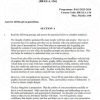
₹ 100.00 ₹ 25.00
Get IGNOU BEGAE-182 Solved Assignment 2023-24 English Medium Soft Copy ready for Download in PDF ( JULY 2023 JAN 2024 )
Buy Handwritten Assignment ( Scan PDF or Hard Copy)
- Description
- Reviews (0)
Are you a student of IGNOU looking for high-quality and accurate IGNOU BEGAE-182 Solved Assignment 2023-24 English Medium ? Look no further than our IGNOU Solved Assignment PDF Our digital product provides you with the most comprehensive and reliable IGNOU assignments, complete with detailed solutions and step-by-step explanations. Our team of experts has years of experience and in-depth knowledge of IGNOU’s curriculum, ensuring that our solved assignments meet the highest standards of quality and accuracy. With our IGNOU Solved Assignments PDF product, you can rest assured that you’re getting the best possible help with your coursework. Our solved assignments cover a wide range of subjects and courses, and are designed to help you master the material and succeed in your studies.
So why wait? Get your hands on our IGNOU Solved Assignment PDF product today and take the first step towards academic success!
To purchase your assignment and get instant access, follow these steps:
- Select the assignment, then click on “Add to Cart or Buy Now” to add it to your cart.
- Go to the “View Cart” or “Buy Now” page and click on “Checkout”.
- At checkout, select CCavenue as your payment gateway. Fill in your email address and the necessary information.
- Review your order details to ensure they are correct, then click on “Place Order”.
- You’ll be directed to the payment page where you can select your preferred payment method and complete the transaction.
- Upon successful payment, you’ll be redirected to the download page to access and download your assignment. A download link will also be sent to your email.
If you encounter any technical issues or have further questions, you can reach out via the phone numbers 9891268050, 7982987641, or via email at [email protected] .
Disclaimer:
We provide a full refund if the assignment delivered is incorrect. However, for specific answer issues, it is the student’s responsibility to verify and provide the correct answer. Our assignment solutions are meant for reference only. When assignments offer a choice in the number of answers, we aim to cover the minimum compulsory questions to achieve maximum marks. We base our assignments on IGNOU books and online resources. Please download your assignment within 7 days of payment, as the download link will expire after this period.
There are no reviews yet.
Be the first to review “IGNOU BEGAE-182 Solved Assignment 2023-24 English Medium” Cancel reply
Your review *
Name *
Email *
Save my name, email, and website in this browser for the next time I comment.
Related products

IGNOU BEGLA-137 SOLVED ASSIGNMENT 2023-24 ENGLISH MEDIUM

IGNOU BEGC-134 SOLVED ASSIGNMENT 2023-24 ENGLISH MEDIUM
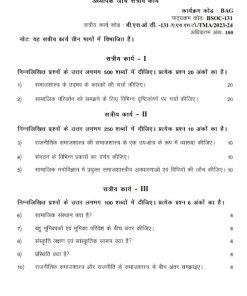
IGNOU BSOC-131 SOLVED ASSIGNMENT 2023-24 HINDI MEDIUM

IGNOU BHDG-175 Solved Assignment 2023-24 Hindi Medium

IGNOU BANC-131 Solved Assignment 2023-24 English Medium
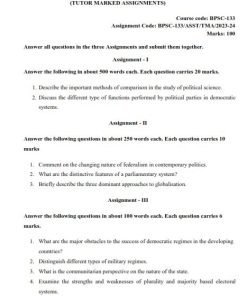
IGNOU BPSC-133 SOLVED ASSIGNMENT 2023-24 ENGLISH MEDIUM
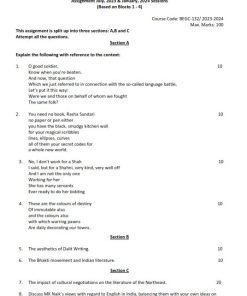
IGNOU BEGC-132 SOLVED ASSIGNMENT 2023-24 ENGLISH MEDIUM
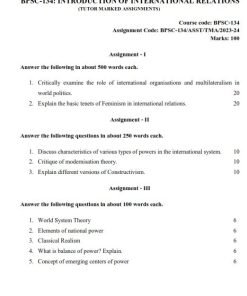
IGNOU BPSC-134 SOLVED ASSIGNMENT 2023-24 ENGLISH MEDIUM
Username or email address *
Password *
Remember me Log in
Lost your password?
Email address *
A link to set a new password will be sent to your email address.
Your personal data will be used to support your experience throughout this website, to manage access to your account, and for other purposes described in our privacy policy .
To stay updated with our latest IGNOU Solved Assignments, join our Telegram Channel!

To stay updated with our latest IGNOU solved assignments, join us on Telegram !

IGNOU BEGAE 182 Solved Assignment 2023-24 English Medium PDF Download
₹ 29.00
Score the maximum possible marks in the minimum possible time with the help of this highest possible quality IGNOU BEGAE 182 Solved Assignment 2023-24 English Medium PDF prepared by a dedicated team of subject matter experts at Vidyamojo.
Why Choose Vidyamojo?
- Helps you to get maximum possible marks.
- Each answer is reviewed and approved by a panel of subject matter experts.
- Outsourcing research and answer compilation saves you a lot of time and effort.
- Trusted by thousands of IGNOU students.
- Based on the guidelines set by IGNOU.
- PDF file can be downloaded immediately after payment.
Description
Before purchasing the IGNOU BEGAE 182 Solved Assignment 2023-24 English Medium PDF, we strongly recommend that you verify the assignment details given below to ensure that it is the assignment you wish to purchase.
IGNOU BEGAE 182 Solved Assignment 2023-24 English Medium PDF Download Details
- Course Code: BEGAE 182
- Course Title: English Communication Skills
- Session: July 2023-January 2024
- Medium: English
- Assignment Code: BEGAE-182/2023-24
- University: IGNOU
IGNOU BEGAE 182: English Communication Skills (July 2023-January 2024) Assignment Questions
Answer all questions. 1. What do you understand by the term ‘non-verbal communication’? What are its advantages?
2. Write a short note on Macro functions of communication.
3. How do you differentiate between Group Discussions at Interviews and Group Discussions in General?
4. What are “homonyms” and “homophones”? Explain with suitable examples.
5. What are some of the meeting etiquettes which one must follow while attending a meeting? Also suggest ways to end a meeting.
6. A construction company is planning to cut down several trees in your locality to build new flats. As the President of your Residential Association write a formal letter to the editor of your local newspaper highlighting this issue.
7. You are attending an international Conference in your city. You have just met a participant from the U.S.A. Write a dialogue in 10 turns where both of you get introduced to each other and discuss your expectations from the conference.
8. Write an essay on Barriers to communication.
9. A group of five students have been given the topic “Environment Pollution and ways to curb it” for group discussion. Attempt a group discussion for a set of three students.
10. You have been invited to speak in a webinar for high school students on the topic: “Contribution of Youth in Nation building” Write your speech in around 300 words.
So get a copy of the IGNOU BEGAE 182 Solved Assignment 2023-24 English Medium PDF now and complete your assignment in no time.
Apart from this, you can also check our huge collection of IGNOU Solved Assignments where you will find solved assignments of all the courses.
Reviews (0)
There are no reviews yet.
Your email address will not be published. Required fields are marked *
Your review *
Name *
Email *
Save my name, email, and website in this browser for the next time I comment.
Related products
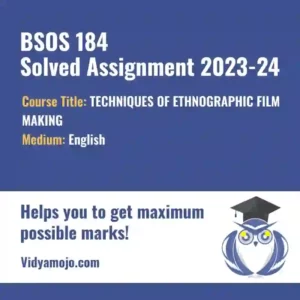
IGNOU BSOS 184 Solved Assignment 2023-24 English Medium PDF Download
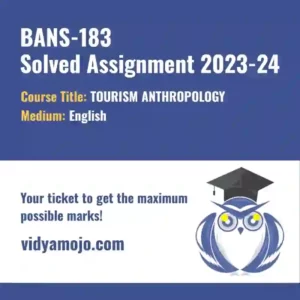
IGNOU BANS 183 Solved Assignment 2023-24 English Medium PDF Download
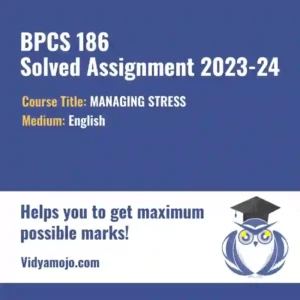
IGNOU BPCS 186 Solved Assignment 2023-24 English Medium PDF Download
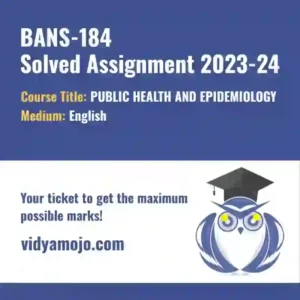
IGNOU BANS 184 Solved Assignment 2023-24 English Medium PDF Download
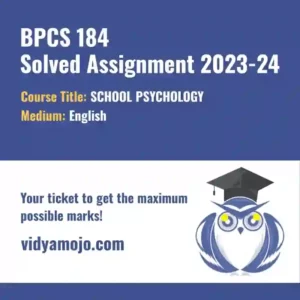
IGNOU BPCS 184 Solved Assignment 2023-24 English Medium PDF Download
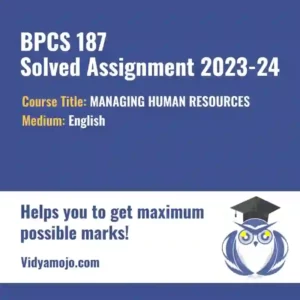
IGNOU BPCS 187 Solved Assignment 2023-24 English Medium PDF Download
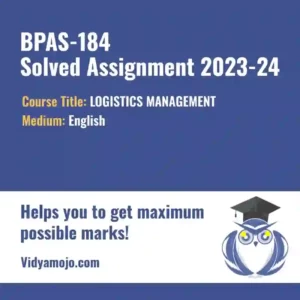
IGNOU BPAS 184 Solved Assignment 2023-24 English Medium PDF Download
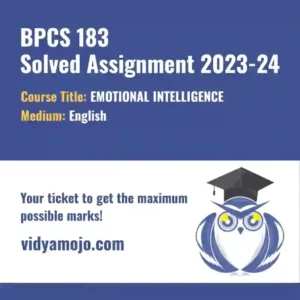
IGNOU BPCS 183 Solved Assignment 2023-24 English Medium PDF Download

- B.A (VOCATIONAL STUDIES) TOURISM MANAGEMENT (BAVTM) solved assignment / B.A IGNOU HISTORY SOLVED ASSIGNMENT / B.A IGNOU POLITICAL SCIENCE SOLVED ASSIGNMENT / B.A IGNOU PUBLIC ADMINISTRATION SOLVED ASSIGNMENT / B.A IGNOU SOCIOLOGY SOLVED ASSIGNMENT / B.SC IGNOU MATHEMATICS SOLVED ASSIGNMENT / B.SCG IGNOU CHEMISTRY SOLVED ASSIGNMENT / BA Ability Skill Enhancemnt Courses SOLVED ASSIGNEMENT / BA Anthropology SOLVED ASSIGNMENT / BA Economics (Honours) / BA IGNOU ENGLISH SOLVED ASSIGNMENT (BAEGH) / BA Psychology SOLVED ASSIGNMENT / BAG 2ND SEMESTER / BEGAE-182 / IGNOU BCOMG SOLVED ASSIGNMENT / IGNOU BSc Biochemestry (Honours) SOLVED ASSIGNMENT / IGNOU BSCG PHYSICS SOLVED ASSIGNMENT / ignou solved Assignment
FREE IGNOU BEGAE-182 SOLVED ASSIGNMENT 2023-24
by Team Guffo · Published 2023 · Updated 2023
DOWNLOAD HERE IGNOU BEGAE-182 ASSIGNMENT 2023-24 AND ALSO check out IGNOU BEGAE-182 SOLVED ASSIGNMENT 2023-24 GUIDELINES. यहाँ BEGAE-182 ASSIGNMENT 2022-23 डाउनलोड करें और इसके अलावा IGNOU BEGAE-182 SOLVED ASSIGNMENT 2023-24 की GUIDELINES भी देखें।
Which assignments do you have to submit to appear for the June 2024 exam?
Assignment 2023-24 (Last date 30 April 2024)
Which assignments do you have to submit to appear for the December 2024 exam?
Assignment 2023-24 (last date 30 October 2024)
IGNOU BEGAE-182 SOLVED ASSIGNMENT 2023-24 –
1. What do you understand by the term ‘non-verbal communication’? What are its advantages?
Non-verbal communication refers to the transmission of messages and information without the use of spoken or written words. It involves various cues such as facial expressions, gestures, body language, eye contact, tone of voice, posture, and even the use of personal space. Non-verbal communication plays a crucial role in conveying emotions, attitudes, and intentions in both personal and professional settings.
Advantages of non-verbal communication:
- Enhances Understanding: Non-verbal cues complement verbal communication, providing additional context and meaning to the message being conveyed. This enhances the recipient’s understanding of the speaker’s intentions and feelings.
- Expresses Emotions: Non-verbal communication allows individuals to express emotions, such as happiness, sadness, anger, or surprise, more effectively than words alone. It adds emotional depth to interactions.
- Builds Trust: Non-verbal cues, such as eye contact and open body language, contribute to building trust and rapport between individuals. They help create a positive and conducive atmosphere for communication.
- Universal Language: Certain non-verbal cues, like smiling or nodding, are universally understood across cultures. This enables people from different linguistic backgrounds to communicate and connect.
- Supplements Verbal Messages: Sometimes, verbal communication may be ambiguous or incomplete. Non-verbal cues provide additional information that helps clarify the intended message.
- Confirms Verbal Communication: Non-verbal cues act as a feedback mechanism, indicating whether the message has been received and understood correctly or not.
- Imparts Non-threatening Feedback: When offering constructive criticism or feedback, non-verbal cues can make it less intimidating and foster a positive response.
- Strengthens Relationships: Effective non-verbal communication can lead to stronger and more meaningful relationships as it conveys empathy, respect, and genuine interest.
- Influence and Persuasion: Non-verbal cues, such as confident body language and assertive gestures, can enhance the persuasiveness of a message or presentation.
- Negotiation and Problem-Solving: During negotiations, understanding and using non-verbal cues can provide valuable insights into the other party’s stance and intentions.
In summary, non-verbal communication is a powerful tool that complements and enriches verbal communication, leading to more effective and meaningful interactions in various personal and professional settings.
2. Write a short note on Macro functions of communication.
In the realm of communication, macro functions refer to the overarching purposes or objectives that communication serves in society. These functions are broad and serve fundamental roles in facilitating interactions and maintaining social cohesion. The macro functions of communication include:
**1. Information: One of the primary macro functions of communication is to exchange information. It enables individuals to share knowledge, facts, ideas, and opinions with one another. Through communication, individuals stay informed about current events, trends, innovations, and developments in various fields.
**2. Socialization: Communication is essential for the socialization process, particularly in early childhood. It is through communication that individuals learn language, social norms, values, and behaviors of their culture or society. Effective communication fosters a sense of belonging and helps individuals integrate into social groups.
**3. Education: Communication plays a pivotal role in education. It is the medium through which teachers impart knowledge and students ask questions, seek clarification, and engage in discussions. Educational institutions rely on various communication channels to disseminate information and facilitate learning.
**4. Entertainment: Communication serves as a means of entertainment. Whether through storytelling, films, music, or other artistic expressions, communication allows people to relax, enjoy, and escape from the stresses of daily life.
**5. Cultural Preservation: Communication is crucial for preserving and transmitting cultural heritage from one generation to another. It includes oral traditions, folktales, rituals, and cultural practices that are shared through communication channels.
**6. Social Interaction: Communication is vital for social interactions, enabling individuals to establish and maintain relationships. It allows people to express affection, empathy, and emotions, which are fundamental for human connections.
**7. Influence and Persuasion: Communication is a tool for influencing others’ attitudes, beliefs, and behaviors. It is used in advertising, marketing, politics, and public speaking to persuade and motivate audiences.
**8. Conflict Resolution: Communication is essential for resolving conflicts and addressing issues. Effective communication can help identify misunderstandings, find common ground, and seek solutions collaboratively.
**9. Decision Making: In various settings, communication facilitates the decision-making process. It allows stakeholders to exchange ideas, deliberate, and reach consensus or make informed choices.
**10. Social Change: Communication has the power to bring about social change by raising awareness, mobilizing communities, and advocating for specific causes.
In conclusion, the macro functions of communication are diverse and integral to human society. They enable the flow of information, maintain social order, facilitate personal connections, and drive societal progress.
3. How do you differentiate between Group Discussions at Interviews and Group Discussions in General?
Group Discussions (GD) conducted at interviews and group discussions held in general settings have distinct purposes, contexts, and evaluation criteria. Here’s a differentiation between the two:
Group Discussions at Interviews:
- Purpose: Group discussions at interviews are commonly used as part of the selection process for job positions or educational programs. The primary purpose is to assess the candidates’ communication skills, leadership potential, problem-solving ability, and teamwork.
- Focus: The topics for interview GDs are often related to the job profile, industry, or current affairs. The objective is to evaluate how candidates approach relevant subjects and contribute to the discussion.
- Evaluation Criteria: Candidates are assessed on their communication skills, listening ability, clarity of thought, logical thinking, ability to work in a team, and their overall demeanor during the discussion.
- Competition: In interview GDs, candidates compete against each other for the same job or position. The evaluators look for standout candidates who demonstrate both subject knowledge and excellent interpersonal skills.
- Time Constraint: Interview GDs usually have a limited duration, typically ranging from 10 to 30 minutes. This is done to assess how candidates perform under pressure and manage time effectively.
- Decision-making: In some cases, interview GDs may not have a conclusive decision-making component. The individual assessments during the GD are often considered along with other evaluation stages to make hiring or admission decisions.
Group Discussions in General:
- Purpose: Group discussions in general settings can occur in various contexts, such as academic institutions, community gatherings, seminars, workshops, and social events. The purpose may be to exchange ideas, share information, brainstorm solutions, or foster creativity.
- Focus: The topics for general GDs can vary widely, covering diverse subjects ranging from academic subjects to social issues, personal experiences, and creative topics.
- Participation: Participants engage in general GDs voluntarily and may not be competing against each other. The emphasis is often on collaborative learning, knowledge-sharing, and collective problem-solving.
- Evaluation Criteria: While there may not be a strict evaluation process in general GDs, participants are generally encouraged to contribute constructively, respect others’ opinions, and engage in active listening.
- Time Flexibility: General GDs may have more flexible timeframes, allowing participants to delve deeper into discussions and explore different perspectives.
- Decision-making: In most cases, general GDs do not involve a decision-making component, and the focus is more on the process of communication and knowledge exchange rather than reaching a conclusion.
In summary, the key differences lie in the purpose, focus, evaluation criteria, competition, time constraint, and decision-making component between group discussions at interviews and group discussions in general settings.
4. What are “homonyms” and “homophones”? Explain with suitable examples.
Homonyms: Homonyms are words that have the same spelling or pronunciation but different meanings. They may belong to the same part of speech or have different grammatical functions. Homonyms can create confusion in communication, especially in written form, as the context is essential for understanding their intended meaning.
Examples of homonyms:
- Bank (noun): A financial institution where money is kept and transactions are made. Bank (noun): The side of a river, lake, or other water bodies.
- Bat (noun): Nocturnal flying mammal. Bat (noun): A club used to hit the ball in sports like cricket or baseball.
- Tire (noun): A rubber covering around a wheel. Tire (verb): To exhaust or become weary.
- Fair (adjective): Just, equitable, or treating everyone equally. Fair (noun): An event with games, rides, and entertainment.
- Left (adjective): The opposite of right. Left (verb): The past tense of “leave” or “to go away.”
Homophones: Homophones are words that have the same pronunciation but different meanings and spellings. Unlike homonyms, which can be spelled the same or differently, homophones are always spelled differently but may sound identical.
Examples of homophones:
- To (preposition): Expressing motion in the direction of a particular location. Too (adverb): In addition, also, or to an excessive degree. Two (noun): The number 2.
- Their (pronoun): Belonging to or associated with them. There (adverb): In, at, or to that place. They’re (contraction): Short for “they are.”
- Flour (noun): Powder obtained by grinding grains or other foods. Flower (noun): The reproductive part of a plant, often brightly colored.
- Meet (verb): To encounter or come into contact with someone. Meat (noun): Animal flesh used as food.
- Cell (noun): The basic unit of life in organisms. Sell (verb): To exchange goods or services for money.
In summary, homonyms are words with the same spelling or pronunciation but different meanings, while homophones are words that have the same pronunciation but different spellings and meanings.
5. What are some of the meeting etiquettes which one must follow while attending a meeting? Also suggest ways to end a meeting.
Meeting Etiquettes:
Following proper meeting etiquettes is essential to ensure productive and respectful interactions. Here are some important meeting etiquettes that one must follow while attending a meeting:
- Be on Time: Arrive at the meeting on time, or even a few minutes early. Punctuality shows respect for others’ time and allows the meeting to start promptly.
- Come Prepared: Review the meeting agenda and any relevant materials beforehand. Be ready to contribute and participate actively in the discussions.
- Silence Devices: Silence or turn off your mobile phones and other electronic devices to avoid distractions and disruptions during the meeting.
- Listen Actively: Pay attention to what others are saying. Avoid interrupting and demonstrate active listening by nodding or providing appropriate verbal cues.
- Speak Respectfully: When you speak, be concise and respectful to others’ opinions. Avoid dominating the conversation and give others a chance to express their thoughts.
- Stay on Topic: Stick to the agenda items and avoid discussing unrelated matters that can derail the meeting’s purpose.
- Raise Hands: In larger meetings, raise your hand or wait for an appropriate pause to speak. This helps maintain order and prevents multiple people from talking simultaneously.
- Avoid Side Conversations: Side conversations can be distracting and disrespectful to the speaker. Focus on the meeting’s proceedings and save unrelated discussions for later.
- Maintain Eye Contact: Maintain appropriate eye contact with the speaker to show engagement and attentiveness.
- Respect Time Limits: If the meeting has time limits for each agenda item, adhere to them to ensure that all topics are adequately addressed.
Ways to End a Meeting:
Ending a meeting smoothly is just as important as starting one effectively. Here are some ways to end a meeting professionally:
- Summarize Key Points: Before concluding the meeting, briefly summarize the key decisions, action items, and conclusions reached during the discussion.
- Ask for Questions and Feedback: Give attendees an opportunity to ask any final questions or provide feedback on the meeting process.
- Assign Action Items: Clearly state the action items decided during the meeting and assign responsibilities to specific individuals.
- Set the Next Meeting Date: If necessary, decide on the date, time, and agenda for the next meeting to keep everyone informed and prepared.
- Thank Participants: Express appreciation to all attendees for their contributions, ideas, and time.
- Confirm Follow-up Communication: If additional information or updates are required, specify how and when these will be communicated.
- End on Time: Be mindful of participants’ schedules and end the meeting on time as per the scheduled duration.
- Adjourn the Meeting: Formally declare the meeting adjourned to indicate that it has concluded.
By following these meeting etiquettes and concluding the meeting professionally, you ensure that meetings are productive, respectful, and time-efficient.
6. A construction company is planning to cut down several trees in your locality to build new flats. As the President of your Residential Association, write a formal letter to the editor of your local newspaper highlighting this issue.
[Your Name]
[Your Address]
[City, State, Zip Code]
[Email Address] [Date]
The Editor [Newspaper Name]
Subject: Concerns Over Planned Tree Cutting for New Flats in Our Locality
Dear Sir/Madam,
I hope this letter finds you in good health and high spirits. I am writing to bring to your attention an urgent matter that deeply concerns the residents of our locality. It has come to our attention that a construction company, [Construction Company Name], is planning to cut down several trees in our beloved neighborhood to make way for the construction of new flats.
As the President of the [Residential Association Name], I represent the collective voice of our residents, who are deeply invested in the preservation and sustainable development of our community. Our locality has long been cherished for its greenery, which not only enhances the aesthetic beauty of the area but also contributes significantly to the overall well-being of our residents.
The proposed tree cutting poses multiple environmental and societal challenges. Trees play a crucial role in purifying the air we breathe, mitigating noise pollution, and maintaining a conducive climate. Furthermore, they provide habitat for various species of birds and wildlife, fostering biodiversity in our urban landscape.
Moreover, the felling of trees can lead to soil erosion and disrupt the natural water drainage system, potentially exacerbating the risk of flooding during heavy rains. The loss of green cover would also adversely impact the mental health and general quality of life for the residents, as studies have shown the positive effects of proximity to nature.
While we recognize the need for urban development, we firmly believe that it should be carried out responsibly and in harmony with the environment. We urge the concerned authorities to explore alternative solutions that would allow for the construction of new flats without resorting to extensive tree cutting.
Our community strongly advocates for sustainable development practices, such as integrating green spaces into construction plans, adopting eco-friendly building materials, and exploring vertical construction to minimize the ecological footprint.
We kindly request your esteemed newspaper’s support in raising awareness about this critical issue. By highlighting the potential consequences of unchecked tree cutting, we hope to rally public support and influence decision-makers to opt for a more environmentally conscious approach to development.
We remain hopeful that through collaborative efforts, we can strike a balance between urban progress and environmental preservation. We look forward to your newspaper’s support in advocating for a greener, more sustainable future for our beloved locality.
Thank you for your time and attention to this matter. Please feel free to contact me at [Your Phone Number] or [Your Email Address] if you require any further information or wish to discuss this issue in greater detail.
Yours sincerely,
[Your Name] President, [Residential Association Name]
7. You are attending an international Conference in your city. You have just met a participant from the U.S.A. Write a dialogue in 10 turns where both of you get introduced to each other and discuss your expectations from the conference.
You: Hello! I’m excited about this conference. My name is [Your Name]. I’m from the host city.
U.S. Participant: Hi there! I’m equally thrilled to be here. I’m [Participant’s Name] from the United States. Nice to meet you!
You: Great to meet you too, [Participant’s Name]. Is this your first time attending this conference?
U.S. Participant: No, this is my second time. I attended the previous one in New York. How about you?
You: This is my first time attending an international conference. I’m eager to learn from diverse perspectives.
U.S. Participant: That’s wonderful! These conferences offer fantastic opportunities for cross-cultural learning. What do you hope to gain from this event?
You: I’m particularly interested in the keynote speeches and panel discussions. I hope to gain insights into the latest trends in our industry.
U.S. Participant: Same here! Networking is also a significant benefit. Meeting people from different countries can open up new collaborations.
You: Absolutely! Have you attended any workshops before? I’m considering joining a few during the conference.
U.S. Participant: Yes, I find workshops very enriching. I’m planning to attend a workshop on sustainable practices in our field.
You: That sounds intriguing! Our industry can make a significant impact through sustainable initiatives. Is there anything specific you’d like to achieve during the conference?
U.S. Participant: I hope to share some best practices from the U.S. and gain insights on how other countries are approaching similar challenges.
You: That’s a great approach! Exchanging knowledge and experiences can lead to valuable takeaways. How about exploring the local attractions during our free time?
U.S. Participant: Absolutely! I’ve heard this city has some beautiful landmarks. I’m looking forward to exploring it.
You: That’s wonderful to hear. If you need any recommendations, feel free to ask. Let’s make the most of this conference and our time here.
U.S. Participant: I couldn’t agree more. It was a pleasure meeting you, [Your Name]. Let’s stay in touch throughout the conference.
You: Likewise, [Participant’s Name]. Let’s exchange contact details and catch up during the breaks.
U.S. Participant: Sounds like a plan! Here’s my card. Looking forward to an inspiring conference!
You: Thank you! Likewise. Enjoy the conference!
8. Write an essay on Barriers to communication.
Communication is an essential aspect of human interaction, enabling the exchange of ideas, information, and emotions. However, various barriers can hinder effective communication, leading to misunderstandings, conflicts, and inefficiencies. Understanding these barriers is crucial for individuals and organizations to overcome them and ensure smooth and meaningful communication.
**1. Language Barriers: Differences in language and vocabulary can impede communication, particularly in multicultural or international settings. Misinterpretations and misunderstandings may arise when people speak different languages or use complex terminology.
**2. Cultural Barriers: Diverse cultural norms, customs, and communication styles can create challenges in understanding and interpreting messages. Gestures, tones, and expressions may be interpreted differently across cultures.
**3. Physical Barriers: Physical distance, noisy environments, or technical issues with communication devices can hinder the clear transmission of messages.
**4. Perceptual Barriers: Individual perceptions and biases influence how messages are received and interpreted. People may selectively filter information based on their preconceived notions, leading to communication breakdowns.
**5. Emotional Barriers: Strong emotions, such as anger, fear, or stress, can cloud judgment and hinder effective communication. Emotional responses may lead to defensive reactions, making it difficult to address issues constructively.
**6. Information Overload: When there is an excessive amount of information to process, individuals may struggle to prioritize and comprehend the key messages, leading to communication fatigue.
**7. Lack of Feedback: Communication is a two-way process. Without adequate feedback, the sender may remain unaware of whether the message has been understood correctly, leading to further misunderstandings.
**8. Semantic Barriers: Words can have multiple meanings, leading to confusion and misinterpretation if the context is not clear.
**9. Organizational Barriers: Hierarchical structures, bureaucratic processes, and poor communication channels within organizations can impede the flow of information.
**10. Personal Barriers: Shyness, introversion, and low self-esteem may prevent individuals from expressing themselves openly, hindering effective communication.
**11. Credibility Issues: When the credibility of the sender is in question, the recipients may be less receptive to the message, leading to skepticism and disbelief.
**12. Time Constraints: Rushed interactions due to time limitations can result in incomplete communication, overlooking essential details.
**13. Gender Barriers: Differences in communication styles between genders can lead to misunderstandings and misinterpretations.
To overcome these barriers and enhance communication effectiveness, individuals and organizations can employ several strategies:
**1. **Language: Use clear and simple language, and if necessary, provide translations or use interpreters to bridge language gaps.
**2. **Cultural Awareness: Learn about different cultures and communication norms to adapt messages appropriately.
**3. **Active Listening: Focus on listening attentively, seeking clarification when needed, and providing feedback to the speaker.
**4. **Emotional Intelligence: Develop emotional intelligence to manage emotions during conversations and foster empathy.
5. Effective Feedback Mechanisms: Establish feedback loops to ensure that messages are understood correctly.
6. Use of Visuals: Incorporate visual aids to complement verbal communication and reinforce messages.
7. Training and Development: Provide communication training and workshops to improve overall communication skills.
8. Open Communication Channels: Create an environment where individuals feel comfortable expressing their thoughts and ideas.
9. Addressing Information Overload: Prioritize and summarize essential information to prevent overwhelming recipients.
10. Promote Inclusivity: Encourage diverse perspectives and ensure that all voices are heard in discussions.
By acknowledging and addressing these barriers, individuals and organizations can foster a culture of effective communication, leading to enhanced collaboration, understanding, and productivity.
9. A group of five students has been given the topic “Environment Pollution and ways to curb it” for group discussion. Attempt a group discussion for a set of three students.
Student A: Hello everyone, let’s start our discussion on environment pollution and ways to curb it. I think one of the most significant contributors to pollution is vehicular emissions. We need to find ways to reduce it.
Student B: I agree, Student A. One way could be to promote the use of public transportation and carpooling. If more people use buses or trains instead of individual cars, we can significantly reduce air pollution.
Student C: That’s a good point, Student B. Additionally, we should encourage the adoption of electric vehicles (EVs). They produce zero tailpipe emissions and can play a vital role in curbing air pollution.
Student A: Absolutely, Student C. Another aspect we need to address is plastic pollution. Single-use plastics are a major environmental threat. We should promote the use of eco-friendly alternatives and raise awareness about plastic recycling.
Student B: I completely agree, Student A. We also need stricter regulations and policies to restrict the use of single-use plastics, especially in packaging.
Student C: Along with that, I think industries play a significant role in causing pollution. We should advocate for cleaner production processes and technologies to reduce industrial pollution.
Student A: Yes, Student C. Industries should adopt sustainable practices and invest in technologies that minimize waste and emissions.
Student B: And what about water pollution? It’s a crucial issue that often gets overlooked. We must take measures to prevent industrial and agricultural runoff from contaminating our water bodies.
Student C: You’re right, Student B. Implementing effective waste management systems can also prevent waste from ending up in our oceans and rivers.
Student A: Additionally, I believe education plays a vital role in curbing pollution. We need to raise awareness among people, especially the younger generation, about the consequences of pollution and the importance of protecting our environment.
Student B: I couldn’t agree more, Student A. Engaging in community clean-up drives and environmental campaigns can be effective in educating and involving the public.
Student C: Overall, to curb pollution, it requires a multi-pronged approach, involving governments, industries, communities, and individuals. We need collective action to preserve our environment for future generations.
Student A: Well said, Student C. If we all take responsibility and work together, we can make a significant positive impact.
Student B: I’m glad we discussed these points. Now, let’s summarize our key ideas and prepare to present them to the rest of the group.
Student C: Agreed. Let’s highlight the importance of promoting sustainable practices, reducing vehicular emissions, addressing plastic pollution, and raising awareness through education.
10. You have been invited to speak in a webinar for high school students on the topic: “Contribution of Youth in Nation-building.” Write your speech in around 300 words.
Good morning/afternoon, everyone! I feel honored and delighted to be addressing all the brilliant high school students attending this webinar today. The topic we are exploring – “Contribution of Youth in Nation-building” – holds tremendous significance as young minds like yours play a crucial role in shaping the future of our nation.
[The Power of Youth] They say, “The youth of a nation are the trustees of posterity.” This quote emphasizes the immense responsibility and potential that lies within each one of you. Youth possesses the energy, enthusiasm, and fresh perspectives needed to propel our nation forward.
As young individuals, you are not just the leaders of tomorrow; you are the torchbearers of today. The positive impact you make today will reverberate in the years to come, creating a better, stronger, and more prosperous nation for all.
[Education and Awareness] Education and awareness are the foundation of progress. I urge each one of you to embrace learning with open minds and hearts. Education equips you with the knowledge and skills to face challenges and seize opportunities. Stay curious, ask questions, and strive for excellence in your academic pursuits.
But education must go hand in hand with awareness. Be informed about the issues our nation faces, whether it’s related to the environment, social inequality, or economic development. Empower yourself with knowledge, for it is the key to meaningful change.
[Embracing Social Responsibility] Your generation is known for its passion for social causes and activism. Embrace this spirit of social responsibility and channel it towards constructive endeavors. Get involved in community service projects, volunteer for NGOs, and work towards uplifting the underprivileged.
Be the voice for the voiceless, and advocate for justice and equality. Your collective efforts can address social issues and bridge the gaps that persist in our society.
[Innovating for Tomorrow] Innovation and entrepreneurship are catalysts for progress. Your generation is witnessing unprecedented advancements in technology and digitalization. Embrace these tools to create innovative solutions for real-world problems.
The next breakthrough idea might come from one of you sitting in this webinar. Seize every opportunity to unleash your creativity and turn your visions into reality.
[Political Engagement] Active participation in the democratic process is vital. As you approach voting age, educate yourself about the political landscape and the policies that shape our nation’s destiny.
Your vote is your voice , and it can bring about substantial changes in governance. Engage in constructive political discussions, question policies, and demand accountability from your leaders.
In conclusion, I have unwavering faith in the potential of the youth. Each one of you has the power to be a positive force in nation-building.
Remember, you are not just the future; you are the present. Embrace your roles as responsible citizens, change-makers, and nation-builders. Together, let’s create a future that we can be proud of – a future where the dreams and aspirations of all are realized.
Thank you for your attention, and I’m excited to witness the incredible contributions each one of you will make.
Tags: bachelor of arts assignment BEGAE 182 ignou BEGAE 182 ignou solved assignment 2023 BEGAE 182 ignou solved assignment 2023-2024 BEGAE 182 ignou solved assignment 2024 BEGAE 182 PDF. BEGAE 182 solved assignment 2023 BEGAE 182 Solved assignment 2023-2024 BEGAE 182 solved assignment 2024 BEGAE 182 solved handwritten assignment 2023 BEGAE 182 solved handwritten assignment 2023-2024 BEGAE 182 solved handwritten assignment 2024 hindi assignment IGNOU BEGAE-182 IGNOU BEGAE-182 SOLVED ASSIGNMENT IGNOU BEGAE-182 SOLVED ASSIGNMENT 2023-24 IGNOU BEGAE-182 SOLVED ASSIGNMENT 2023-24 PDF IGNOU BEGAE-182 SOLVED ASSIGNMENT 2023-24 PDF ENGLISH IGNOU BEGAE-182 SOLVED ASSIGNMENT 2024 MA ASSIGNMENT
- Next story FREE IGNOU BEGC-132 SOLVED ASSIGNMENT 2023-24
- Previous story IGNOU Vocational Courses: Empowering Through Skill-Based Education
You may also like...

IGNOU BEGE-101 QUESTION PAPER DECEMBER 2021
by Team Guffo · Published 2022

IGNOU BANC-104 SOLVED ASSIGNMENT 2020-21
by Team Guffo · Published 2020 · Last modified 2021

MEG-10 IMPORTANT QUESTION OF Block 7 Evolutions of Canons in Indian English Writing
by Team Guffo · Published 2019 · Last modified 2021
Leave a Reply Cancel reply
This site uses Akismet to reduce spam. Learn how your comment data is processed .

- [email protected]
- RAMPHAL CHOWK DWARKA DEC 7 DELHI
- 10 AM To 6 PM

IGNOU BEGAE-182 Solved Assignment 2023-24 English Medium
₹ 50.00 ₹ 20.00
Get IGNOU BEGAE-182 Solved Assignment 2023-24 English Medium Copy ready for Download in PDF ( July 2023- January 2024 sessions)
Buy Handwritten Assignment ( Scan PDF or Hard Copy)
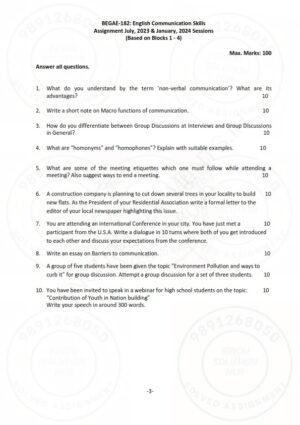
Description
- Reviews (0)
Are you a student of IGNOU looking for high-quality IGNOU BEGAE-182 Solved Assignment 2023-24 English Medium? Look no further than our IGNOU Solved Assign ment PDF Our digital product provides you with the most comprehensive and reliable IGNOU solved assignments, complete with detailed solutions and step-by-step explanations. Our team of experts has years of experience and in-depth knowledge of IGNOU’s curriculum, ensuring that our solved assignments meet the highest standards of quality and accuracy. With our IGNOU Solved Assignment PDF product, you can rest assured that you’re getting the best possible help with your coursework. Our solved assignments cover a wide range of subjects and courses, and are designed to help you master the material and succeed in your studies.
So why wait? Get your hands on our IGNOU Solved Assignment PDF product today and take the first step towards academic success!
To purchase the assignment and receive it instantly, follow these steps:
- Click on the “Add to Cart or Buy Now” button to add the assignment to your cart.
- Proceed to the “View Cart” or “Buy Now” page.
- Click on the “Checkout” button to proceed with the purchase.
- On the checkout page, you will be given CCavenue as your payment gateway.0
- Enter your email address and provide the necessary information as requested.
- Click on “Continue” to proceed to the next step.
- Review your order details and ensure they are correct.
- Click on “Place Order” to confirm your purchase.
- After placing your order, you will be directed to the payment page.
- Choose your preferred payment method, such as UPI, Wallets, Net Banking, or Credit/Debit Card, and complete the payment process.
- Upon successful payment, you will be redirected to the download page , where you can instantly access and download your solved assignment.
- Additionally, a download link for the assignment PDF will be sent to the email address you provided during the purchase.
Please note that the delivery type mentioned is for an auto-generated PDF available for download on the website’s download section and sent via email. If you have any further questions or encounter any technical issues , you can contact the provided phone numbers (9891268050, 7982987641) or email ( [email protected] ) for assistance.
- We offer a full 100% refund if the assignment delivered to you is incorrect or contains incorrect content.
- In the case of a specific answer issue, it is the student’s responsibility to conduct research and provide the correct answer.
- Our assignment solutions are intended to serve as references only.
- When assignments provide options for the number of answers to be written, we focus on covering the minimum compulsory questions to maximize marks.
- We create assignments using IGNOU books and online resources.
After making a successful payment on the website, you will have a duration of 7 days to download the assignment from the website’s download section. Additionally, a download link for the assignment PDF will be sent to your email.
Please ensure to download the assignment within 7 days of the payment, as the download link will expire after that time.
There are no reviews yet.
Your email address will not be published. Required fields are marked *
Your review *
Name *
Email *
Save my name, email, and website in this browser for the next time I comment.
Related products
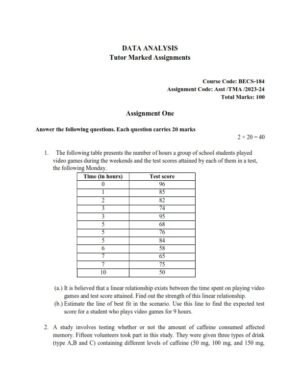
IGNOU BECS-184 Solved Assignment 2023-24 English Medium
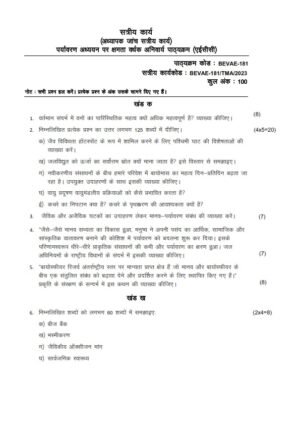
IGNOU BEVAE-181 Solved Assignment 2023 Hindi Medium

IGNOU BEGAE-182 SOLVED ASSIGNMENT 2023-24 ENGLISH MEDIUM
Ignou bese-142 solved assignment 2023-24 english medium.
- 0 ₹0.00
- Add to cart
BEGAE-182: English Communication Skills
Ignou solved assignment solution for 2021-22, if you are looking for begae-182 ignou solved assignment solution for the subject english communication skills, you have come to the right place. begae-182 solution on this page applies to 2021-22 session students studying in bag, bcomg, bscg, bavtm, baech, bahih, bapsh, bapah, bapch, basoh, baegh, bscanh, bscbch, baegh, bapfhmh, bbaril, bavmsme, bafsm, bags, diril courses of ignou., looking to download all solved assignment pdfs for your course together, begae-182 solved assignment solution by gyaniversity.
Assignment Code: BEGAE-182/2021-22
Course Code: BEGAE-182
Assignment Name: English Communication Skills
Year: 2021-2022
Verification Status: Verified by Professor
Answer all questions
Answer the following in about 150 words each: 5x5=25
Q1. What do you understand by the term ‘non-verbal communication’?
Ans ) It is not necessary for all communication that communicates a message to be spoken. A grin, a frown, or silence can all be used to express our feelings. Nonverbal communication is any form of communication that does not involve the use of words. According to Albert Mehrabian, a psychology professor, nonverbal communication accounts for 55 percent of a message's impact. Nonverbal communication can take the form of either visual or audio communication.
Nonverbal communication includes symbols, signs, sounds, eye contact and face expression, bodily postures, gestures, and physical appearance. Silence is also included in this category. Drums and fire were utilised as a form of communication in the past, when communication media were less established. People would communicate by pounding drums in a relay system. For example, a vehicle on a highway only needs to see a picture of a gas station or a phone on a sign post to know what is available nearby.
Q2. What are the conventions of a conversation? How does it differ from other speech events?
Ans ) People can connect and communicate through conversations. Because talks usually involve at least two people, there are some rules to observe when chatting with someone. This type of action, as well as social gatherings utilised to communicate with others, paints a positive picture of the individual. The first guideline is to listen first and then talk. One should not interrupt while the other is speaking in order to communicate well. One should not abruptly end another's discourse.
Difference between speech and conversation:
Speeches contain and include rationally organised and ordered concepts, whereas talks might drift about topics/subjects.
Speeches utilise formalised language, but dialogue uses slang, sometimes with poor grammar, and sometimes with profanity.
S peeches are typically given in planned, purposeful settings and scenarios, whereas discussions happen on their own.
Q3. What is meant by the ‘schema theory’? How is it important in understanding the reading process?
Ans ) Schema theory is a subfield of cognitive science that studies how the brain organises information. A schema (plural: schemas or schemata) is an ordered unit of information based on prior experience for a subject or event. Individuals use schema to help them understand and act on their current situation. To construct comprehension, readers use the two forms of processing interchangeably, whether consciously or unconsciously. Readers can use schema theory to help them make sense of new experiences and create predictions about what they might expect to encounter in a certain situation.
Understanding the reading process requires knowledge of schema theory:
As a result, one of the most essential functions of schema is to assist readers in matching what they know with what the written text informs them, or in monitoring their comprehension.
I f there is a shortcoming at the level of analysing print, such as decoding issues such as poor word recognition, the higher-level knowledge of the topic will compensate.
Q4. Discuss any two difficulties that learners of English as a second language are likely to encounter while learning English vocabulary.
Ans ) The two difficulties that learners of English as a second language are:
One Word Many Meanings (Homonyms)
Homonyms are words that have the same spelling and pronunciation but have distinct meanings depending on their context. The term club has several different connotations in the following lines. You might have gone to a neighbourhood club in your colony as a kid. You may have seen a picture of Bhim holding a club in the Mahabharat television series, and if you play cards, you will come across clubs in the pack.
Same Sound Different Form and Meanings (Homophones)
Take these two terms as an example: break and brake. Both words have the same pronunciation (sound), but their written forms (spelling) are different. The words' meanings are also diverse. The context in which the word is used determines which spelling to choose. Homophones are words that have the same sound but differing spelling and meaning.
Q5. What are the four levels of meaning that you need to be aware of as a reader?
Ans ) The four levels of meaning that you need to be aware of as a reader are:
Literal comprehension entails the reader comprehending the information immediately expressed in a text. Facts and details, sequences of events, primary concepts and generalisations, causes and effects are all examples of information. The fact that the information is present "in black and white" in the text is crucial to comprehension at this level. It is not necessary for the reader to delve too deeply to find it.
Interpretive : Reading at the interpretive level, on the other hand, entails reading 'between the lines,' recognising thoughts and information that aren't explicitly stated. To put it another way, the reader must analyse the information presented in the book and make the inference by putting two and two together.
Critical : Making judgments about a book is a requirement of critical reading. The reader can assess the veracity of the facts, the validity of the conclusions reached, and the author's style.
Creative : Innovative reading necessitates the development of new concepts, insights, applications, and methods. It necessitates creativity, foresight, and imagination.
Q1. You are attending an International Conference in your city. You have just met a participant from the U.S.A. Write out a dialogue in 10 turns where both of you get introduced to each other and discuss your expectations from the conference. 10
Ans ) Dialogues:
Naina: Hello! Mr. Sam. How are you?
Sam Tidon: Hey! I’m totally fine and what about you?
Naina: I am good too.
Sam Tidon: Have you been attended such an international conference yet?
Naina: Yes, I have been. This conference is quite different from all and interesting as well.
Sam Tidon: Education with corona is likely to be on the same pace now. We can’t stop education because of this pandemic.
Naina: Yeah! It’s true. People should pay attention to their protection. No law can impose complete protection to all.
Sam Tidon: Covid-19 put the impact on various walks of life i.e. education, health, economic etc.
Naina: So many people lost their lives and loved ones too.
Naina: Governments must take more severe measures in this regard, and citizens must be commended for their efforts in combating the pandemic.
Naina: It was quite an interesting conference today; did you enjoy this?
Sam Tidon: Without a doubt. Even though it was my first visit to India, it was the nicest trip I've ever taken. Thank you so much for having such a lovely talk with me.
Naina: Once again, welcome to India. Greetings, Mr. Sam.
Q2. You have been invited to speak in a webinar for high school students on the topic: “Challenges faced by school students in India during the COVID-19 lockdown.” Write out your speech in around 250 words. 10
Ans ) Speech:
Today, I, Naina Thakur, would like to share my thoughts on a hot topic: 'Challenges faced by Indian school pupils during the COVID-19 lockdown.' State governments around the country temporarily closed schools, colleges, and institutions due of the COVID-19 outbreak.
It is unclear when schools, colleges, and institutions will reopen, given the current scenario. Several university entrance exams and competitive examinations are held during this season, making it a significant time for the education sector. Millions of students are struggling to face the demands of online classrooms as the digital divide has spread across India, further separating the wealthy from the impoverished and the tech-savvy from the tech-poor.
'Student participation is the most important factor in the success of online courses. In an online setting, delivering the knowledge component is more natural. The transfer of talents over the internet is case-by-case. Conducting a design studio in an online mode, for example, could be difficult. It's possible that a lab-based trial won't be possible. I believe that skill-based courses can also be addressed.
As students and teachers in villages, cities, and towns struggle to meet the demands of the times, the field of education, which never realised its full potential, has become potholed, lively, and bumpy-lumpy. The COVID-19 pandemic, which has forced people into their homes and forced schools, colleges, and universities to take virtual classes, has blown up educational dreams with minimal requirements: a computer or, at the very least, a smartphone, a reliable Internet connection, and a steady power supply. All of this made education difficult.
Many of us have had a difficult year in 2021. We cannot, however, allow it to be a squandered year. We must all learn the harsh lessons that this year taught us as we approach the new year. The COVID-19 epidemic must be over by 2022. However, it must also mark the start of something new: a new period of solidarity. We must mourn the loss of 2021 and look ahead to 2022 with optimism.
Q1. Discuss the semantic and linguistic barriers to communication. Give suitable examples. 20
Ans ) Different domains, such as interpersonal communication, social interaction, and job challenges, can all be affected by a semantic barrier. Interpersonal communication refers to how coworkers or employees interact with one another on a regular basis in the workplace. Professional communication is another term for this.
The term "workplace relationships" encompasses a wide range of interactions. Workplace communication can take many forms, including water cooler chats, meeting debates, and Zoom calls. Social interaction is a vital communication component in the job and occasionally after hours, yet it's often disregarded. It could include chats among coworkers regarding business and personal interests. They might take place over dinner, cocktails, or in the corporate gym. As a result, all of these situations might lead to communication obstacles due to semantic barriers.
Use of idioms
Misunderstood words
Non-native speakers
Missed or misinterpreted jokes
Differences in emoting
Tech trouble
Lack of information
The most common types of communication hurdles in the workplace are language or linguistic limitations. It leads to misunderstandings and misinterpretations among coworkers, putting a strain on their working relationships. Language, whether verbal, nonverbal, or even sign language, is required for all forms of communication. Language obstacles emerge as a result of the incapacity to communicate via language. It refers to the difficulties that people or groups who speak different languages and dialects confront (in some cases).
Linguistic obstacles arise when people who speak different languages are unable to communicate with one another. There is a linguistic and communicative breakdown. However, the breadth of language communication hurdles is far broader. There are subtle distinctions that are brought about by a specific industry. Using technical language at work, for example, can be difficult for a new hire. Using the wrong words can detract from an employee's experience, resulting in low morale and job satisfaction.
There are also language difficulties based on culture that can be a hindrance. What one culture considers courteous may be deemed disrespectful in another. Using direct language with managers, for example, may be considered disrespectful in some cultures. Employees may be discouraged from speaking up and providing feedback to their bosses as a result of this. Body language, gestures, and facial emotions are all nonverbal indicators that have distinct interpretations. When dealing with a diverse workforce, it's critical to keep these points in mind.
Q2. “Writing is commonly seen as a three-way process: pre-writing, writing and re-writing.” Explain this statement. 20
Ans ) Writing is commonly seen as a three-way process: pre-writing, writing, and re-writing. It may appear that writing proceeds in a sequential, step-by-step manner. However, it almost always proceeds in a recursive fashion. This simply implies that writers revisit their ideas on a regular basis, clarifying, expanding, or refining them. Most writers will plan and then revise their plans, as well as write and rewrite parts or entire draughts, until the very last moment, when they must submit or send to the reader in question.
Pre-writing
You plan and prepare your writing at the pre-writing stage. This is also the time when you do your research and look for appropriate sources for your topic.
You should consider the subject and goal of your project early in the pre-writing step.
If your instructor has assigned you a broad subject, you will need to narrow it down and concentrate on a narrower subject area, preferably one that interests you.
To write successfully, you must first understand why you are writing.
Each sort of writing has its own set of rules and knowing why you're writing will help you create a work that's both high-quality and relevant.
You must interpret the task in order to understand the aim of your writing.
Preparing well for your writing is essential and will save you a lot of time in the long run. It will assist you in maintaining your concentration while writing.
You may need to make changes to your initial strategy as your project advances. It is critical to set aside time at the start of the writing process to construct a writing schedule to ensure that you have a finished output by the deadline.
Consider that the revision phase may take as much time as the initial writing, if not more, when organising your time.
This is comparable to how you would schedule your study in general.
It's time to start writing after you've established an outline. Remember that a perfect first draught is not required.
Rather of concentrating on producing immaculate text at this point, try to focus on getting out your core thoughts. You are not required to an aeon or proofread at this time.
Instead, strive to allow as much freedom as possible in your ideas and writing.
Furthermore, you are not needed to compose the content from beginning to end. It's fine to start with the portions where you're most comfortable.
Before you have a comprehensive text, you will most likely have to modify your draught multiple times. Allowing time between draughts (up to days, if you have the time) will allow you to gain a fresh perspective on your writing.
This is the point in the writing process when you check to see if your work is coherent and well-written.
Your end product should be a text that has been thoroughly researched and meets academic writing standards. Before submitting your assignment, make sure you have enough time to review, edit, and proofread it.
Q3. A group of four students have been given the following topic for group discussion. ‘Internet usage by school students: issues and challenges.” Write out the discussion giving at least 3 turns to each student. 15
Ans ) Group Discussion:
Student 1 : In the field of technological study, e-learning poses considerable obstacles. Students' connectedness and communication are improved by using the internet. Connectivity and communication among students has improved, making it faster and more effective than before. The internet has made a significant contribution to students' study and education; students can conveniently and comfortably study and learn via the internet. Students may easily connect with professionals all around the world, talk with them, and learn from them. Many students benefit from the internet in their studies and learning; they can easily study online using the internet.
Student 2 : Aside from the benefits and beneficial effects of the internet for students, the internet has a negative side for kids. There are numerous drawbacks to using the internet as a student. More than likely, the internet diverts students' attention away from their studies to other pursuits.
Student 3 : Excessive Internet use is mostly responsible for social isolation. The majority of students are afflicted by the internet problem. Students who spend a lot of time on the internet become cut off from the rest of the world. They don't want to go outdoors and speak with their friends, relatives, and family members because they want to spend all of their time surfing the Internet. For students, the internet creates a slew of privacy difficulties. Everyone has access to the Internet, and everyone is free to use it. The majority of the time, the data and privacy of students are jeopardised. Hackers use the Internet to break into students' computers and phones, steal personal information, and blackmail them. Many of the students' photos and videos have gone popular on social media and the Internet. Because of the Internet, many students commit suicide.
Student 4 : Students spend a significant amount of time on the Internet. They always appear to be surfing the web. Also see BSOG-173 English Medium Solved Assignment 2021-22. For students, one of the most crucial things is their limited time. For them, every second counts.
Student 2 : Because the internet benefits students in a variety of ways and makes their lives easier, they should use it. It increases communication, but it has a significant impact on pupils' communication abilities.
Student 3 : Because the internet opens up the world to pupils, they may build connections and speak with people from all over the world, learning about different cultures and lifestyles.
Student 1 : One of the most serious negative consequences of the internet on pupils in school is the addiction to excessive Internet use. The addition of the internet has an impact on the majority of students. They always want to use the Internet and not do anything else as a result of the addition of the Internet. Student education, study, and learning are all disrupted significantly as a result of Internet addiction.
Student 2 : One of the most common negative consequences of the Internet is cyberbullying among students. The majority of pupils use the Internet to bully other students. Because of the growing popularity of the Internet. Bullying and cybercrime are also on the rise. Cheating, fraud, and cyberbullying on the internet have a negative impact on students' lives. Many students commit suicide as a result of internet cyberbullying.
Student 4 : Anonymity is a result of extensive Internet use. Students can use the Internet to participate in websites, forums, communities, and chat rooms. In addition, many people participate in forums, communities, and chat rooms. It allows for wicked people to take advantage of innocent pupils on numerous occasions, abusing and bullying them.
100% Verified solved assignments from ₹ 40 written in our own words so that you get the best marks!
Don't have time to write your assignment neatly? Get it written by experts and get free home delivery
Get Guidebooks and Help books to pass your exams easily. Get home delivery or download instantly!
Download IGNOU's official study material combined into a single PDF file absolutely free!
Download latest Assignment Question Papers for free in PDF format at the click of a button!
Download Previous year Question Papers for reference and Exam Preparation for free!
Download Premium PDF
Assignment Question Papers
Which Year / Session to Write?
Get Handwritten Assignments

IMAGES
VIDEO
COMMENTS
Download. BEGAE 182 Solved Assignment 2023-24 ( English Communication Skills) FREE PDF Available here. All the assignment questions answers are solved in this article. Some students who need the BEGAE 182 Solved Assignment PDF, can download the pdf from this blog. Before may any assignment match the assignment questions with the assignment ...
If you are looking for BEGAE-182 IGNOU Solved Assignment solution for the subject English Communication Skills, you have come to the right place. BEGAE-182 solution on this page applies to 2023-24 session students studying in BAG, BCOMG, BSCG, BAVTM, BAECH, BAHIH, BAPSH, BAPAH, BAPCH, BASOH, BAEGH, BSCANH, BSCBCH, BAEGH, BAPFHMH, BBARIL, BAVMSME, BAFSM, BAGS, DIRIL, BATS, BAJDM courses of IGNOU.
Begae 182 IGNOU solved assignment 2023-24. "Looking for BEGAE 182 IGNOU solved assignment 2023-24 (Free) ? Master your English Communication Skills with our comprehensive and expertly crafted solved assignment. Score high marks in the Tutor Marked Assignment (TMA) carrying 100 marks. Our meticulously prepared solution ensures a critical ...
BEGAE-182: English Communication Skills. Assignment July, 2023 & January, 2024 Sessions. (Based on Blocks 1 - 4) Max. Marks: 100. Answer all questions.
BEGAE - 182 English Communication Skills (BEGAE - 182) Course Code: BEGAE-182/2023-24 Dear Student You are required to do one assignment for the Course titled English Communication Skills Code BEGAE-182, which will be a Tutor Marked Assignment (TMA) and will carry 100 marks. It will be based on blocks 1 to 4.
BEGAE 182 solved assignment 2023-24 | Begae 182 solved assignment 2023-24 in English| begae 182WHATSAPP NO - 8199887784 WHATSAPP LINK - https://wa.link/6t9jn...
BEGAE-182 English Communication Skills Solved Assignment 2023-2024 DOWNLOAD NOW Assignment July, 2023 & January, 2024 Sessions (Based on Blocks 1 - 4) Max. Marks: 100 Title Name BEGAE-182 Solved Assignment 2023-2024 University IGNOU Service Type Solved Assignment (Soft copy/PDF) Course BAG(English) Language ENGLISH Semester 2023-2024 Course: BA(English) Session Assignment July, 2023 ...
IGNOU BAG Hindi Solved Assignment; BEGAE 182 Previous Year Question Paper Download in PDF, important questions from BEGAE-182 English Communication Skills, ASSIGNMENT SOLUTIONS GUIDE (2023-2024-2025). BEGAE - 182, ASSIGNMENT SOLUTIONS GUIDE (2022-2023). BEGAE - 182. IGNOU BEGAE-182 EXAM Notes and solved assignment questions Paper-1. Section A ...
BEGAE-182 assignment question paper and solved assignment is applicable for 2023-24 sessions in IGNOU. In case you took admission or re-registered in a previous session but did not submit your assignments previously, you must use this latest question paper for submission as the old question papers are no longer valid.
Yes, you can download IGNOU BEGAE 182 Solved Assignments for previous years from the websites listed above. Last Date of Submit IGNOU BAECH Assignment. For July Session Admission : 15th April Session. For Jan Session Admission : 15th October Session. IGNOU BEGAE 182 Solved Assignment July 2023- January 2023-2024 in English Medium Free Download ...
BEGAE-182/2022-23. IGNOU BEGAE 182 Solved Assignment 2022-2023: It is an invaluable resource for students pursuing Bachelor's Degree in Education (B.Ed) from Indira Gandhi National Open University (IGNOU). The course "Educational Evaluation and Assessment" (BEGAE 182) is a crucial part of the B.Ed program, and the solved assignment serves ...
Course Code: BEGAE-182/2022-23 Dear Student You are required to do one assignment for the Course titled English Communication Skills Code BEGAE-182, which will be a Tutor Marked Assignment (TMA) and will carry 100 marks. It will be based on blocks 1 to 4. Aims: This assignment is concerned mainly with assessing your application and your
Alongside --assignment status, they will also checkout their assignment marks & result. All this is often available in a web mode. After submitting the assignment, you'll check you BEGAE 182 Solved Assignment 2023-24 only after 3-4 weeks. BEGAE 182 Solved Assignment 2023-24 it'd take 40 days to declare BEGAE 182 Solved Assignment 2023-24
IGNOU BEGAE-182 Solved Assignment 2023-24 English Medium. ₹ 100.00 ₹ 25.00. Get IGNOU BEGAE-182 Solved Assignment 2023-24 English Medium Soft Copy ready for Download in PDF ( JULY 2023 JAN 2024 ) Efficient assistance saves time and effort. Effective time management leads to high grades. Answers provided are verified and accurate according ...
BEGAE 182 solved Assignment 2023-2024 | BEGAE 182 ignou handwritten assignment 2023-2024 | IGNOU BEGAE 182 English in daily life assignment | BAG assignment ...
Additionally, we understand the significance of timely submission in IGNOU's academic environment. With our IGNOU BEGAE-182 Solved Assignment 2023-24, you can bid farewell to last-minute rush and stress. We provide you with a ready-to-submit assignment that saves you precious time and ensures you meet the deadline with confidence.
begae 182 solved assignment 2023-24ignou begae 182 english communication skills assignment answer 2023 july batch, 2024 January batch#ignou2023 #ignouassignm...
IGNOU BEGAE 182 Solved Assignment 2023-24 English Medium PDF Download. ₹ 29.00. Add to cart. Score the maximum possible marks in the minimum possible time with the help of this highest possible quality IGNOU BEGAE 182 Solved Assignment 2023-24 English Medium PDF prepared by a dedicated team of subject matter experts at Vidyamojo.
IGNOU BEGAE-182 Solved Assignment 2022-23 ASSIGNMENT NO: BEGAE-182: SERVICE TYPE: Solved Assignment (Soft Copy/PDF) Programme: BEGAE-182/2023-24: Course Code: BEGAE-182: SESSION: July 2023- January 2024: COURSE TITLE: SUBMISSION DATE 31st APRIL 2024. 30th OCTOBER 2024
Last Date of Submission of IGNOU BEGAE-182 (BAEGH) 2023-24 Assignment is for January 2023 Session: 30th September, 2023 (for December ... July 2023 Session: 30th September, 2023 (for December 2023 Term End Exam). Title Name: ignou BEGAE 182 solved assignment 2023 2024: Type: Soft Copy (E-Assignment) .pdf: University: IGNOU: Degree: BACHELOR ...
Begae 182 Solved Assignment 2023-24 In English | Begae 182 SOLVED ASSIGNMENT 2024 | Begae 182 English Communication Skills 2024Paid Promotion Email 📧rohitka...
Get IGNOU BEGAE-182 Solved Assignment 2023-24 English Medium Copy ready for Download in PDF ( July 2023- January 2024 sessions) Efficient assistance saves time and effort. Effective time management leads to high grades. Answers provided are verified and accurate according to IGNOU guidelines.
If you are looking for BEGAE-182 IGNOU Solved Assignment solution for the subject English Communication Skills, you have come to the right place. BEGAE-182 solution on this page applies to 2021-22 session students studying in BAG, BCOMG, BSCG, BAVTM, BAECH, BAHIH, BAPSH, BAPAH, BAPCH, BASOH, BAEGH, BSCANH, BSCBCH, BAEGH, BAPFHMH, BBARIL, BAVMSME, BAFSM, BAGS, DIRIL courses of IGNOU.